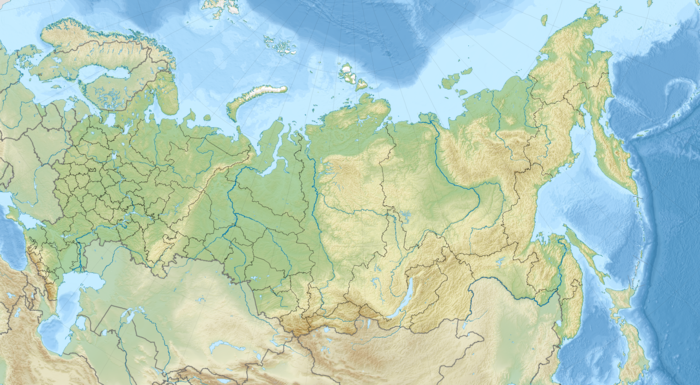Russia
![]()
This article is about the Russian state, in the narrower sense the Russian Federation; for other meanings see Russia (disambiguation).
Template:Infobox State/Maintenance/TRANSCRIPTION
Template:Infobox State/Maintenance/NAME-German
Russia (Russian Россия [rɐˈsʲijə]![]() , transcription Rossiya), officially the Russian Federation (or according to the Russian designation Russian Federation; Russian. Российская Федерация,
, transcription Rossiya), officially the Russian Federation (or according to the Russian designation Russian Federation; Russian. Российская Федерация,![]() , transcription Rossiyskaya Federatsiya) is a federal state in Eastern Europe as well as Northern Asia. With about 17 million square kilometers, Russia is the largest state in terms of area, covering about one-ninth of the Earth's land mass. With 144.5 million inhabitants (2019), it is the 9th most populous country and also one of the most sparsely populated.
, transcription Rossiyskaya Federatsiya) is a federal state in Eastern Europe as well as Northern Asia. With about 17 million square kilometers, Russia is the largest state in terms of area, covering about one-ninth of the Earth's land mass. With 144.5 million inhabitants (2019), it is the 9th most populous country and also one of the most sparsely populated.
The European part of the national territory is much more densely populated and urbanized than the Asian part, which is over three times as large: about 77 % of the population (110 million inhabitants) live west of the Urals. The capital, Moscow, is one of the largest cities and metropolitan regions in the world; another important center is Saint Petersburg, which was the capital between 1712 and 1918 and was a bridge for art and culture from Western Europe. Russia's next largest megacities are Novosibirsk in Siberia, Yekaterinburg on the Urals, and Nizhny Novgorod on the Volga. Other metropolitan regions are Chelyabinsk, Ufa, Kazan and Samara. In total, Russia has 15 cities of one million inhabitants and almost 70 agglomerations with more than 500,000 inhabitants. Russia's federal structure consists of eight federal districts and 85 federal subjects.
Today's Russian Federation developed from the Grand Duchy of Moscow, a constituent principality of the former East Slavic empire of Kievan Rus, into a multi-ethnic state of over 100 ethnicities, with ethnic Russians now accounting for nearly 80 percent of the population. It is a "continuator state" of the Soviet Union in international organizations and a permanent member of the World Security Council. It is one of the recognized nuclear powers and possesses the world's largest arsenal of weapons of mass destruction. Russia is a great power and a regional power and is sometimes considered a potential superpower. It is also a member of the Council of Europe, APEC, the Shanghai Cooperation Organization (SCO), the OSCE, the WTO; it is a leading member of the Commonwealth of Independent States (CIS), the Collective Security Treaty Organization (CSTO), and the Eurasian Economic Union (with Armenia, Kazakhstan, Kyrgyzstan, and Belarus).
Russia is an upper middle-income emerging market. After recovering from the post-communist transformation crisis of the 1990s, Russia became the world's sixth-largest economy by purchasing power parity, between Germany and Brazil (2016 estimate). Russia's reserves of raw materials are probably the largest in the world at around 20-30%, with significant deposits of primary energy sources, especially natural gas.
According to the wording of the constitution, political scientists usually classify Russia's system of government formally as a combination of presidential and parliamentary forms. The constitutional reality of the political system, however, corresponds more to models of defective democracies or post-democracy, especially since the president exercises almost autocratic power. Officials occasionally use the term "articulated democracy" in an affirmative sense to describe the political order in Russia.
The annexation of Crimea in March 2014 strained relations between Russia and the West. The Russian government is accused of violating the European peace order.
Geography
|
|
With 17,075 million square kilometers, Russia is by far the largest country on earth. It covers eleven percent of the world's land area, which is roughly the same as Australia and Europe combined. Except for the tropics, all climate zones are represented.
From west to east, Russia stretches over a total length of 9000 kilometers, from 19° east to 169° west across two continents. Europe accounts for 23 percent of the land area, Asia for 77 percent. From south to north the extension is up to 4000 kilometers, from the 41st to the 81st degree of northern latitude.
The territory of Russia is home to some of the longest rivers as well as the oldest and deepest inland lake in the world (Lake Baikal). Comparing the relief structure and river systems of Russia, a grid of width-parallel watersheds or the steppe belt in the south and the meridionally oriented streamways emerges.
Location and boundaries
Apart from the People's Republic of China, Russia has the largest number of neighboring states with a common land border (14). The total length of the country's borders is 20,027 kilometers. Russia also borders five seas, with a coastline of 37,653 kilometers.
The Russian heartland borders the countries of Norway (196 km) and Finland (1340 km), followed by a short coastal strip to the Baltic Sea. In addition, Russia shares a border with the Baltic countries of Estonia (334 km) and Latvia (217 km), followed further south by Belarus (959 km) and Ukraine (1586 km, with land border of Crimea). The Black Sea separates Russia's European borders from its Asian ones. The Caucasus is bordered by Georgia (723 km) and Azerbaijan (284 km). This is followed by a coastal strip on the Caspian Sea and a long common border with Kazakhstan (6846 km). In East Asia, Russia first borders the People's Republic of China (about 40 km) and then Mongolia (3485 km). After that, Russian territory meets Chinese for the second time (3605 km). North Korea (19 km) is the last land connection with another state.
Then follow the coastlines to the Sea of Japan, the Sea of Okhotsk, the Pacific Ocean and finally the Bering Sea. Russia is separated from Alaska in the far east by the Bering Strait, which is only about 85 km narrow and 30 to 50 meters deep. Russia's Great Diomedes Island, located in the middle of the Bering Strait, is only four kilometers from the U.S.'s Little Diomedes Island. The entire northern part of the country borders on the Arctic Ocean. There are several islands belonging to Russia, as the northernmost Franz Josef Land. Russia also considers other areas of the Arctic Ocean and ice surface as part of its territory.
In addition to the heartland, Russia also has an exclave, the northern part of former East Prussia, today's Kaliningrad Oblast. The area, over which the Soviet Union claimed territorial sovereignty in 1945, borders Lithuania (227 km) and Poland (206 km) and is thus completely surrounded by EU countries.
Russia is divided into eleven time zones (from UTC+2 to UTC+12), and with the abolition of the time change in 2011, daylight saving time applied everywhere all year round until 2014. After persistent criticism from the population, Russia returned to standard time on October 26, 2014.
See also: Time zones in Russia
Large landscapes and relief
→ Main article: Russian major landscapes
Russia comprises a large number of different natural areas, which have diverse potentials, but also very different uses. From a geographical point of view, Russia is divided mainly into the eight major landscapes (roughly in a west-east direction):
- The Eastern European Plain occupies most of European Russia. It consists of wide lowlands interrupted by weakly indented ridges. Only a few elevations reach heights of more than 300 meters. In Karelia and on the Kola Peninsula, which geologically belong to the Baltic Shield, the relief is more differentiated in the north. There, in the Chibins of the central Kola Peninsula, a maximum height of 1191 meters is reached. In the south, the East European lowlands merge into the Caspian depression, which lies below sea level. During the last ice age a chain of terminal moraines was formed, which runs from the border area with Belarus eastward and north of Moscow to the Arctic coast west of the Pechora River. The region north of it consists of many lakes and swamps.
- East of the Ural Mountains, the wide-stretched plain of the West Siberian Lowland continues to the Yenisei River. This exceedingly flat area is occupied by extensive marshlands.
- The Northern Siberian Lowland joins the Central Siberian Highlands to the north, rising to the Taimyr Peninsula to the south of the Arctic Ocean.
- East of the Yenisei extends to the Lena River the undulating Central Siberian Mountains with average altitudes between 500 and 700 meters. In the northwest of this region rises the Putorana Mountains, which reach a maximum height of 1701 meters. Rivers formed the shape of the landscape, in some places deep canyons have cut.
- In the south of Central and Eastern Siberia, other mountain ranges continue eastward to the Pacific Ocean (South Siberian Mountains). These include Altai, Sayan Mountains, Jablonovy Mountains, Stanovoi Mountains and Djugjur.
- The Middle Yakutian Lowland includes mainly the lower valleys of the Lena and Vilyui Rivers, but also the lower Aldan Valley. The lowland, which covers about 1 million km², is bordered by the Central Siberian Mountains to the west and the East Siberian Mountains to the east.
- East of Lena and Aldan is the East Siberian Mountain Range, which consists of branched mountain ranges. The higher mountains in this region, such as Verkhoyansk Mountains, Chersky Mountains and Kolyma Mountains, reach heights between about 2300 and 3200 meters. There are about 160 volcanoes on the Kamchatka Peninsula. The volcanic mountain range of Kamchatka continues in the south on the Kuril Islands. There are about 100 volcanoes there.
- South of the East Siberian Sea opens up the vast East Siberian Lowland, which is located exclusively north of the Arctic Circle. The landscape includes the lower reaches of the rivers Jana, Indigirka and Kolyma. The western part is the Jana-Indigirka lowland, the eastern part is the Kolyma lowland. In the west, south and east the East Siberian Lowland borders on the East Siberian Highland.
Rivers and lakes
With 120,000 rivers and streams and almost two million lakes, Russia is very rich in water. The forest belt, which covers two-thirds of the country, together with the excess precipitation, acts as a huge water reservoir, feeding a whole network of watercourses.
In the European part of Russia, the most important river is the Volga. It is the longest river in Europe and runs exclusively through Russia. Together with its two tributaries, the Kama and the Oka, it drains a large part of the East European Plain after 3534 kilometers to the Caspian Sea in the southeast. As a waterway, the Volga is of special importance as it connects Eastern Europe with Central Asia. The North Russian Land Ridge forms the watershed between the Volga Basin and the White Sea or Barents Sea in the north. The Dnieper River (also known as the Dnieper) is of great importance for the Slavic states. The river originates west of Moscow and then flows through Belarus and Ukraine, where it flows into the Black Sea. It is connected to the Polish rivers Bug and Vistula via the Dnepr-Bug Canal and indirectly to the Memel River via the Oginsk Canal System, making the Dnepr an important waterway.
The longest rivers in Russia are located in Siberia and far eastern Russia. The Ob rises in the Altai region of southern Siberia and flows into the Arctic Ocean. The river, with its headwaters the Katun, is over 4300 kilometers long and forms - together with the Irtysh - one of the longest river systems in Asia with a total length of over 5400 kilometers. The Yenisei river system, whose waters flow (in part) from Mongolia north through western Siberia to the Arctic Ocean, has an even slightly longer flow distance. Its main tributary, the Angara, is the only outflow from Lake Baikal. The Yenisei delivers about 600 cubic kilometers of water annually to the Arctic Ocean. Thus, it records the highest flow rate of all Russian rivers. The Lena River, which is about 4300 kilometers long, is the longest river that runs exclusively in Russia and whose catchment area is located exclusively in Russia. It first flows in a northeasterly direction, turns north after the confluence with the Aldan, and flows in an extensive delta into the Laptev Sea, a tributary of the Arctic Ocean. Other important rivers that flow into the Arctic Ocean are the Pechora, the Northern Dvina, the Khatanga, and the Kolyma and Indigirka.
Another important river system is the Amur with its tributary Shilka. With its source river Onon, it has a total length of about 4400 kilometers and runs from northeastern Mongolia in an easterly direction along the Chinese border to the Pacific coast. Amur and Anadyr are the largest Russian rivers flowing into the Pacific Ocean.
Many other rivers are important as transport routes and as sources of energy, or they serve for irrigation in dry regions. The Don River occupies a prominent position among them. It is located in the populous East European lowlands and drains south into the Sea of Azov. Other important rivers are Moskva, Selenga, Tobol, Stony Tunguska, Lower Tunguska, Ural and Ussuri.
There are many natural lakes in Russia, especially in the formerly glaciated northwestern part of the country. The Caspian Sea is the world's largest inland lake, covering 386,400 km². The lake level of the saltwater lake is about 28 meters below sea level. Since the Caspian Sea has no outflow, water escapes only by evaporation, which leads to the crystallization of salts in the dry climate prevailing here. As the oldest freshwater lake, Lake Baikal has a depth of 1642 meters, which makes it not only the deepest lake, but also the largest reservoir of liquid freshwater in the world (about one fifth of all liquid freshwater reserves). Other important and large lakes are Lake Ladoga (the largest inland lake in Europe), Lake Onega and Lake Taimyr.
See also: List of waterfalls in Russia
Mountains and nature reserves
Around 40 percent of Russia's surface is covered by mountains. The Urals form the dividing line between the European and Asian parts of the country; however, due to its low altitude of just under 2,000 meters (Narodnaya, 1895 m), it does not represent a real barrier. To the east of the Urals is the very flat West Siberian Lowland, which reaches as far as the Yenisey River and is interspersed with extensive marshlands. To the southeast, the West Siberian Lowlands are closed by the Central Siberian Highlands, which extend to the Lena River and slope down to the narrow North Siberian Lowlands in the north. The Central Siberian Highlands include the Sayan Mountains (Munku Sardyk, 3491 m) and the highest mountain range in Siberia, the Altai (Belukha, 4506 m), in the Russian-Kazakh-Chinese-Mongolian border region. East of the Lena River rises the East Siberian Mountains, which branch out into various mountain ranges, such as the Verkhoyansk Mountains (2389 m in Orlugan) and Chersky Mountains (Pobeda, 3003 m), and reach heights of up to a good 3,000 m. The Kamchatka peninsula is characterized by its 160 volcanoes with heights up to 4688 m, 29 of which are still active.
Other mountains in Russia are: Baikal Mountains, Chibins, Caucasus Mountains, Kolyma Mountains, Putorana Mountains, Stanovoi Mountains, Stanovoi Highlands, Tannu-ola Mountains. The highest mountain in Russia is Elbrus (5642 meters) in the Caucasus. It is followed by Kazbek with 5047 meters and Klyuchevskaya Sopka with 4750 meters.
Russia has a distinctive nature conservation system with a long tradition. In addition to the classic Russian protected area categories such as the strictly protected Sapowedniki or Sakasniki, national parks established according to international criteria and other international protected area categories have been added since the 1980s. Russia has one of the largest protected area systems in the world in terms of area:
- Sapowedniki (strictly protected areas): Is the most important national protected area category in Russia, which internationally belongs to the highest possible protected area category. In them no use and no human influence on natural processes is allowed. Therefore, visitors are prohibited from entering the core zone of a sapowednik, although there are limited exceptions for scientists. Currently there are 100 of these total reserves in Russia, ranging in area from 2.31 to 4169 km² and covering a total of 27,000 km².
- Sakasniki (wildlife sanctuaries): These are areas covering up to 6000 km² where restrictions on economic use apply. They serve as landscape reserves for the protection and regeneration of natural ecosystems, the protection of rare animal and plant species, fossil sites or the protection of hydrologically or geologically important sites. In total there are about 3000 Sakasniki in Russia with a total area of about 78,000 km².
- National parks in Russia: It is only since the beginning of the 1980s that Russia has had the protected area category of national parks, which has been known in other countries for some time. These have a lower protection status than the sapowedniki and, in addition to protecting natural and cultural treasures, also serve research and education as well as controlled tourism. There are currently 35 national parks in Russia, ranging in area from 7 km² to 18,900 km², and together they cover 90,000 km² of national territory.
- Nature parks: They are a relatively new category of protection and serve not only nature conservation but also recreation.
- Natural heritage: In 1972, the Convention Concerning the Protection of the World Cultural and Natural Heritage was adopted, to which Russia acceded in 1988. Natural heritage includes unique physical, biological and geological formations or areas whose conservation is of exceptional value for science or because of their natural beauty, as well as habitats of endangered animal and plant species. To date, the following areas have been included by UNESCO as natural heritage sites:
- 1995 - Komi virgin forests
- 1996 - Lake Baikal
- 1996 - Kamchatka volcanic region with nature park
- 1998 - Altai Mountains
- 1999 - Western Caucasus
- 2001 - Nature Reserve Central Sichote-Alin
- 2003 - Uws-Nuur Basin
- 2004 - Wrangel Island Nature Reserve
- 2010 - Putorana Mountains
Climate and vegetation zones
Large parts of the country are characterized by the continental climate with hot summers and very cold winters. The further one travels towards the east of the country, the more clearly one feels the formative temperatures at the different seasons, that is, the summer is extremely hot and the temperatures in the winter months sometimes icy cold. Hardly any other country offers such differences in temperature as Russia. The southern half of the Far East has a monsoon climate. Average January temperatures are below freezing everywhere except the Black Sea coast. In eastern Siberia, they drop to -35 to -60 °C, but are easier to endure because of the usually very low humidity. Summer temperatures vary widely. Average temperatures in the far north are +1 to +2 °C, while in the semi-steppe and steppe areas of the south they are +24 to +25 °C.
The climatic, vegetation, and ecological zones in Russia run largely parallel to the width of the circle, creating a north-south sequence:
The Northern Arctic Ocean is a hostile cold desert. This affects, among others, the northern part of the Taimyr Peninsula and other islands located there. There is a distinct ice climate, in which there are hardly any plants. There are few permanent settlements in this zone. The average temperatures rise just above freezing point for only three months, and in the coldest months of January and February they reach -30 °C. Annual precipitation in the form of snow rarely rises above 250 millimeters.
Starting from the northernmost Eurasian mainland, a treeless landscape belt characterized by permafrost follows, which has a north-south extension of between 200 and 800 kilometers and extends approximately to the Arctic Circle, in the Central Siberian Mountains to 70° northern latitude. With the exception of the bay around the White Sea, the coastal landscape in the north is dominated by tundra. Summers there are too short and too cool for forests to form. Average temperatures are above freezing for only four to five months of the year, with the warmest months in the outlying areas averaging over 10 °C. The ground therefore only thaws at certain points in the year. As a result, the ground also thaws only at the surface, allowing the abundant precipitation to accumulate on the frozen subsoil, turning the tundra into a sea of swamps and bogs with vegetation of lichens, grasses, and dwarf shrubs in the summer. Agriculture is not possible, only the indigenous reindeer nomads make a living there. Therefore, there are few human settlements. Further south of the cold steppe, spruce trees first begin to grow singly, and then, together with bog birch and aspen, form forest tundra interspersed with swamps. At its southern border, the forest tundra then smoothly transitions into the forest zone.
This 1000 to 2000 kilometer wide zone runs north along the St. Petersburg-Ufa-Irkutsk-Sakhalin line and forms the boreal zone or taiga. The forest zone crosses the whole of northern Eurasia. Because of this enormous extension it is divided into several subzones of parallel width: The coniferous forest belt (taiga proper) in the north, which dominates the area by far; in central Siberia, the sub-taiga as a transition zone to the steppe; and a mixed forest belt, which, however, only connects to the south in European Russia. The taiga, for its part, forms three sub-zones connected in a width-parallel manner:
- West of the Urals, the northern taiga consists of low spruce forests with occasional birch. Only in Karelia does the pine predominate.
- The middle taiga forms dark spruce forests with inclusions of birch, towards the south increasingly also pine as well as first harbingers of hardwoods like the littleleaf linden. Low fertility of the soil and species poverty of the vegetation makes this landscape unsuitable for agriculture.
- The southern taiga is characterized by a high proportion of hardwoods in the understory, due to more productive soils. The taiga of Siberia is characterized by sparse forests consisting of Siberian larch, spruce and Swiss stone pine.
The forest zone is characterized by continental climate with a strong temperature gradient between hot summers and cold winters. The average annual temperature decreases significantly from west to east. In Pskov it is still 5.1 °C, but drops to 2.3 °C as far as the Urals and reaches only 0.1 °C in Tomsk in western Siberia. In Yakutsk in eastern Siberia, it is then -10 °C. The low annual averages are due to the long and very cold winter in Siberia. In contrast, the average summer temperatures correspond to the Central European average.
In the areas dominated by cool temperate climates, which join the taiga to the south, deciduous and mixed forest grows. This zone runs within Europe in the triangle St. Petersburg-Odessa-Ufa, in Western Siberia in a strip from Chelyabinsk to Krasnoyarsk as well as in the Amur region. The mixed forest zone thus runs in an eastward tapering triangle from the central Carpathians and from the Baltic coast to the southern Urals. The vegetation consists primarily of spruce, pine and oak, before it changes to pure deciduous forest further south. The leading woods there are oak and, in the western Ukraine, beech and hornbeam. Pines, as in the mixed forest area, grow mainly in sandy depressions such as in the Pripjet Basin. East of the Urals there is no mixed forest for climatic reasons. Instead, in Western Siberia, birch groves lead directly from the taiga to the forest steppe. Mixed forest then reappears in the Far East. The mixed forest zone offers acceptable conditions for agriculture in general, the deciduous forest zone good conditions for existence.
Further south follows a steppe belt, which runs along the lower reaches of the Don and Volga rivers, North Caucasus, Caspian Depression and Tuva. The steppe belt is divided into the forest steppe in the north and the steppe proper in the south. The forest dissolves into islands from north to south and finally almost disappears. This is related to the decrease in precipitation towards the southeast, with a simultaneous increase in evaporation intensity. Except in river valleys (as floodplain forest) or in depressions with favorable groundwater conditions, the water stored in the loess soil is not sufficient to meet the liquid requirements of deciduous trees. Therefore, in the forest steppe meadow, and in the steppe proper feather grass formations form the plant cover. The steppe belt is ideal for grain cultivation because of the fertile black earth layer.
On the Black Sea coast between Novorossiysk and Sochi follows a hardwood forest zone. The average temperature on the Black Sea coast is around 20 degrees Celsius. This subtropical part of Russia is characterized by dense forests.
Russia is home to the largest remaining Nordic wilderness regions after Canada. According to Global Forest Watch, around 26 percent of the forests are still intact primeval forests. Most of them are located in Siberia. In the European part, 9 percent of the forests still have this status.
Fauna
The polar climate on the north coast of Russia is a habitat for polar bears, seals, walruses and sea birds. Polar foxes, owls, snow hares, and lemmings live in the tundra that extends southward. In summer, large herds of reindeer and wolves migrate into the tundra. These animals are perfectly adapted to the life-unfriendly conditions of this zone. In the forests of Russia, the diversity of animal species is increasing. Thus, in the taiga and boreal coniferous forests of Russia live moose, reindeer, wolves, bears, sable, squirrels, foxes and the wolverine. Further south, wild boar, mink and deer have spread. Occasionally there are also Siberian tigers. The steppe zone of Russia is the habitat of hamsters, gopher, as well as polecat and steppe fox.
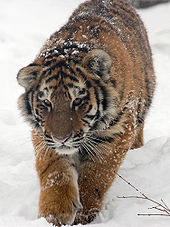
A young Amur tiger in the snow. The game population today is less than 500 animals.

View of Sochi on the Black Sea in the subtropical hardwood forest zone
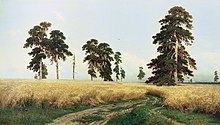
Ivan Shishkin's painting The Rye shows the forest steppe in the central black earth region
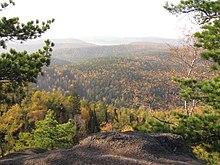
Taiga near Krasnoyarsk

All vegetation zones at a glance: Ice sheets and glaciers Cold desert Lichen and moss tundra Dwarf shrub and meadow tundra Mountain tundra, alpine mats and heaths Hardwood forest tundra and boreal floodplains Coniferous forest tundra Evergreen boreal coniferous forest Deciduous boreal coniferous forest Mixed forest steppes Mixed deciduous and coniferous forests Temperate deciduous and floodplain forests Grass steppes and salt marshes Shrub and dry steppes Winter cold semi-deserts Winter cold deserts Marshes and floodplain aquatic plants

Komi virgin forests
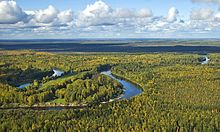
West Siberian Lowland
.jpg)
Koryakskaya Sopka on the Kamchatka Peninsula

The Katun in the Altai Mountains
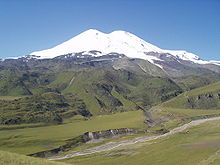
View of Mount Elbrus, the highest mountain in Russia

Cruise ships on the Volga
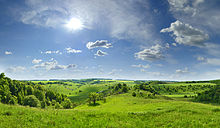
Landscape in Belgorod oblast

Central Russian Land Ridge in the East European Plain, near Saraisk
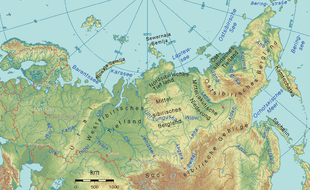
Large landscapes and main rivers of Siberia
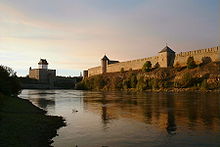
On the right in the picture the fortress Ivangorod (Russia), on the left on the other side of the Narva the Hermannsfeste (Estonia). This is also the eastern border of the European Union.
History
→ Main article: History of Russia and History of the Soviet Union
Russia's history has experienced multiple ruptures since its beginning in the 9th century. Thus, Russian history is a development of its own, which differs significantly from the development of its neighbors in Europe. The reason for this is a constant interplay of typical Russian characteristics from social circumstances and geographical influences, which accompanied its history over long distances. Thus, Russia's geographic position gave it a bridging position between Europe and Asia, which, depending on the strength situation, favored the aggression of foreign powers (major invasions in 1240, 1242, 1609, 1709, 1812, 1917, 1941, among others) or its own expansion. The lack of natural borders contributed to this, which, in interaction with the experience of foreign incursions, led Russia to expand its borders until natural borders could form an effective protection (cf. Russian colonization). This strong need for security in Russia, resulting from historical incursions, continues to this day.
The tension between economic necessities and the way in which the ruling groups cope or fail to cope with them is also one of the constants of Russian history. Examples include the failure to overcome social unrest in the course of the industrial age, culminating in the 1905 revolution, the February and October revolutions of 1917, and the post-communist system transformation of the 1990s.
The ways of thinking inherited from Byzantine orthodoxy led to tensions with modernist tendencies and gave rise to the striking tension between perseverance and progress that was clearly evident, for example, in the schism of 1666/1667 or the Petrine reforms of 1700-1720. Due to the lack of a Roman legal tradition, a right of resistance against sovereign encroachments was missing for a long time, so that the relationship between state power and the economic and political freedom of the individual remained strained. This was particularly evident in the 19th century, when liberal ideas found increased adherents in Russia and manifested themselves in several assassinations against the Russian autocrat (e.g., Decembrist Revolt).
The combination of cooperative and domineering elements, which was pronounced until the end of the Soviet Union, was originally rooted in the Orthodox Church, where the community of believers played a much greater role than the individual, who was responsible to God. Marxists and socialists took up these ideas of the collective in the 19th and 20th centuries and continued them in the Soviet Union. Balancing centralized and decentralized rule has been a constant problem throughout Russia's history. Especially in transitional periods (e.g., between 1240 and 1480, after 1917, and after 1994), centrifugal currents increased at the country's margins.
Ancient Russia, Mongol Storm and Rise of Moscow
The ancient East Slavic name for the territory of the part of European Russia, Belarus and Ukraine inhabited by Slavs was Rus (see Kievan Rus), in Greek Rossia. The present Russian country name Rossiya goes back to this form. The earliest history of European Russia (for the history of the Asian part, see History of Siberia) is marked in the north by Finno-Ugric peoples and Balts, in the south by the Indo-Germanic steppe peoples of the Kurgan people, the Cimmerians, Scythians, Sarmatians and Alans; later Greeks, Goths, Huns and Avars were added here. In the middle, between the Dnieper and the Bug, came the Slavic peoples, who from the 6th century also began to expand to the north and east.
Starting in the 8th century, Scandinavian Vikings navigated the Eastern European rivers and later mixed with the Slavic majority population. These warrior merchants, also called Varangians or Rus, were instrumental in founding the first East Slavic state, Kievan Rus, with centers in Kiev and Novgorod. In the southern steppe region and on the Volga, on the other hand, empires of the Turkic peoples of the Khazars and Volgabulgars, who had streamed in from Asia, had emerged, with whom the Rus traded but also waged war. Intensive contacts with the Byzantine Empire finally led to the Orthodox Christianization of Kievan Rus in 988.
The defective seniority principle regulating succession promoted the fragmentation of Kievan Rus in the 12th century and facilitated the subjugation of the divided Russian principalities in the Mongol invasion. The Mongol invasion of Rus began in 1223 with the Battle of Kalka; the transitional period until the mid-14th century is referred to as the "Dark" Age. Russian national historiography speaks of the "Tartar yoke" of this period. Accordingly, Mongol foreign rule led to a break in relations with the West for two centuries and promoted the isolation of Orthodox Russia. The Russian principalities were within the sphere of power of the Golden Horde, but managed to maintain a certain degree of internal autonomy. Meanwhile, the Russian principalities in the north and west had to fend off attacks from Swedes, Knights of the Order, and Lithuanians. Among the fragmented and hostile Russian principalities, the small and insignificant Principality of Moscow proved to be the most assertive. Dmitri Donskoi, who was able to unite various Russian principalities, defeated the Golden Horde in the Battle of the Field of Snipes in 1380.
The Moscow Grand Duke Ivan the Great ended Mongol rule and became the de facto founder of a centralized Russian state, step by step "collecting" the surrounding Russian lands (Russian собирание земель, sobiranije semel), including the Republic of Novgorod. His title of "ruler of all Rus" also expressed a claim to the western part of Rus ruled by the Grand Duchy of Lithuania in the 14th century. This led to protracted wars in the 16th and 17th centuries with Poland and Lithuania (see Russian-Lithuanian Wars). Under Ivan the Great, Russian legislation was reformed and most of the present Moscow Kremlin was built. His grandson Ivan IV established the Russian tsardom in 1547. Under his rule, after the capture of the Tartar capital of Kazan, the conquest of Siberia also began, bringing Russian Cossacks to the Pacific Ocean for the first time in the 17th century.
Opening of Russia under Peter the Great and rise as a major European power
→ Main article: Russian Empire
At the turn of the 18th century, Tsar Peter the Great opened up the tsardom of Russia, which had become rigid in its old structures, to Western European influences and promoted science and culture. In 1703, he founded the city of SaintPetersburg, which - as the new capital since 1712 - was to become the symbol of Russian progress. With its victory over Sweden in the Great Northern War, which lasted more than 20 years, Russia gained supremacy in the Baltic region after more than 150 years of conflict with Sweden (see Nordic Wars). Russia took over Sweden's position as a major Nordic power in Europe. To underscore his new status in the diplomatic hierarchy of Europe, Tsar Peter had the Russian Tsardom renamed the "Russian Empire" and officially changed the monarch's title from "Tsar" to "Emperor" (Russian Император, Imperator).
Catherine the Great continued Peter's expansionist policy. Under her reign, the Crimean Khanate ("New Russia") was conquered. By participating in the three partitions of Poland, Russia's western border was pushed far toward Central Europe. In 1812, Napoleon's troops invaded Russia and captured Moscow, but were eventually crushed. This gave the prelude to the Wars of Liberation, in which Russian troops with their allies (Prussia, Austria, the United Kingdom, and others) finally defeated Napoleon and forced him to abdicate. Alexander I entered Paris as the "Liberator of Europe." After the Congress of Vienna in 1814/15, Russia gained a dominant role in mainland Europe that lasted until the Crimean War of 1853-1856. However, due to entrenched social structures such as autocracy and serfdom, the agrarian empire was less and less able to keep pace with the rapidly developing industrialized nations. The lost Crimean War against the Western powers exposed the empire's internal weaknesses and provided the impetus for a phase of internal reforms. These accelerated Russia's economic development, but the country was repeatedly destabilized by internal unrest because the political changes were not far-reaching enough and excluded large segments of the population. However, the "Westerners," who propagated the adoption of Western European ways of life and political institutions, were always opposed by the national-romantic "Russophiles" or "Slavophiles," who demanded their own, specifically Russian path to modernity and rejected the blanket adoption of Western values in whole or in large part.
In the large cities, an industrial proletariat emerged at the turn of the century, but very quickly a bourgeois middle class also emerged. This class demanded its share in the disposal of state revenues and co-responsibility for public affairs. The members of the middle class, however, had no common political consciousness. They did not understand political freedom to mean a moral goal, but rather freedom of material development and fair taxation. Thus, the middle class did not allow itself to be guided in the long run by the utopian designs of the intelligentsia. However, the constitutional reality of the state, which would have more closely integrated the middle class, did not adapt. Instead, the terror flared up again. Defeat in the Russo-Japanese War ultimately led to the Russian Revolution of 1905, but the Russian emperor Nicholas II was unwilling to introduce fundamental reforms and had a largely nonfunctional parliament, the Duma, which he had approved of necessity, dissolved again only a short time later.
Russian Revolution and Soviet Union
→ Main article: Russian Soviet Federative Socialist Republic and Soviet Union
When World War I broke out in 1914, Russia, as a member of the Entente, was gripped by a patriotic wave - a mood that initially defined all warring parties, including the German Empire and its allies (Central Powers). The initial successes, especially against Austria-Hungary and the Ottoman Empire, were soon replaced by a war of position until 1917, when the morale of Russian soldiers gave way and the front collapsed. Popular discontent and the bleak supply situation led to demonstrations by workers and peasants in the capital, Petrograd. After a bloody suppression of the demonstrators, they stormed the Winter Palace and Emperor Nicholas II was forced to abdicate.
As a result, a provisionalgovernment (with the participation of the Mensheviks and Social Revolutionaries) came to power in February 1917, functioning as a dual government with workers' and soldiers' soviets.
After the February Revolution of 1917, women in Russia gained the right to vote and stand for election. They were allowed to participate in elections to both soviets and city dumas. In May 1917, a law was passed that gave Russian citizens over 20 the right to vote for the Constituent Assembly. After the October Revolution, the right of women to vote and stand for election was enshrined in the Constitution of the RSFSR of July 10, 1918.
The Bolsheviks emerged victorious from the civil war between "Reds" and "Whites" that followed the October Revolution. The three Baltic states of Estonia, Latvia and Lithuania, as well as Finland, gained their independence from Russia by repelling the Red Army or through prolonged civil wars. In the course of the civil war as well as the following Polish-Russian War, Russia lost parts of Belarus and Ukraine ("Eastern Poland") to Poland in 1920. In 1921, the Russian Soviet Federative Socialist Republic (RSFSR) was proclaimed, which constituted the most important part of the later Soviet Union.
On December 30, 1922, the Soviet Union was created from the previously existing Soviet Russia and a state-controlled economic policy was proclaimed. Soviets were declared owners of land and means of production. Lenin's death on January 21, 1924, led to a bitter succession struggle in which Joseph Stalin prevailed over Leon Trotsky. Stalinism was characterized by targeted terror. Beginning in 1928, the state economy was subjected to five-year plans and the industrialization of the Soviet Union was pushed forward. Forced collectivization in the Soviet Union was accompanied by the campaign of "dekulakization."
In August 1939, the Soviet Union concluded a non-aggression pact with the Nazi state, including in a secret addendum a mutually agreed partition of Eastern Europe. This enabled Hitler to launch the planned war of aggression against Poland in early September 1939, coordinated with a Soviet attack against eastern Poland in mid-September. During the Winter War, the Soviet Union invaded Finland and gained smaller parts of the country. In 1940, Lithuania, Latvia, and Estonia were occupied.
After the German invasion of the Soviet Union on June 22, 1941, which led to the German-Soviet War (called the Great Patriotic War in the Soviet Union), the country joined the anti-Hitler coalition. During the Leningrad Blockade alone, over one million people in Leningrad starved to death. In total, an estimated 27 million Soviet citizens died in this war, 14 million of them civilians. However, it was able to inflict heavy defeats on German forces during the course of the war and was victorious in the final battlefor Berlin in May 1945. After the war, the Soviet Union secured great influence in the neighboring countries of Poland, Czechoslovakia, Hungary, Romania, Bulgaria, Albania and in the GDR. Hundreds of thousands of Soviet soldiers remained stationed in these countries. The Cold War dominated world politics until 1989.
The last Soviet president, Mikhail Gorbachev, initiated a restructuring of the political and economic system in the Soviet Union starting in 1987 with "perestroika" and promoted the transparency and openness of the state leadership toward the population with the policy of "glasnost," whereupon individual union republics sought independence from the Soviet Union. After the unsuccessful August 1991 coup in Moscow by conservative communists, President Boris Yeltsin of Russia and representatives of the Soviet republics decided to dissolve the USSR on December 31, 1991.
Russian Federation since 1992
As the largest former Soviet republic (Russian SFSR), the Russian Federation has exercised the rights and obligations of the USSR under international law since 1992. In the early years, domestic political conflicts arose over the course to be taken. In the Russian constitutional crisis of 1993, Yeltsin dissolved by ukase the Congress of People's Deputies and the Supreme Soviet of Russia, which had resisted his efforts and the results of a referendum on April 25, 1993, to implement economic reforms. Yeltsin ordered a violent storming of the parliament building (White House), where about 100 parliamentarians and other supporters had barricaded themselves. The violent suppression of another uprising against him on October 3 and 4 left 190 people dead in Moscow. In December, the Russian people approved the new constitution of the Russian Federation (bicameral system, presidential administration) by referendum.
Under Yeltsin, parts of the Russian economy were privatized and reforms were attempted. In the process, valuable companies ended up in the hands of people who had good relations with rulers or paid them bribes and protection money ("oligarchs").
There was a ruble crisis in 1991/92. Gross domestic product (GDP) in 1993 was 12 % lower than in 1992 and 29 % lower than in 1991. Industrial production in 1993 was 31.3 % lower than in 1991, consumer goods production 24.8 % lower and food production 27.3 % lower. 2400 production plants were temporarily closed in October 1993 and 4280 in February 1994. Strikes, e.g. in the coalfields, had serious macroeconomic consequences due to non-payment of wages and salaries.
Inflation was high for years and large parts of the population became impoverished. In 1998, the country slipped into insolvency (→ Russian crisis). Especially during the transition period, centrifugal currents increased on the country's peripheries due to the strengthening of regional autonomies after the end of the strongly centralized Soviet era. Thus, since the mid-1990s, the Russian government has been confronted with independence movements and power struggles in numerous republics, especially in the First Chechen War of 1994-96, in which tens of thousands of people died. From early fall 1999 to early 2000, Russian troops brought most of Chechnya back under their control (see Second Chechen War).
The chaotic years under Yeltsin unsettled many people. The birth rate was low; crime, alcoholism, etc. were widespread. In the final phase of Yeltsin's rule, Russian foreign policy consisted almost entirely of empty threats and reactions. This applied, for example, to NATO's eastward expansion and the war in Kosovo. Also, some striking events, such as the sinking of the Kursk in August 2000, the days-long burning of Moscow's Ostankino television tower, and the end of Mir in March 2001, fostered the feeling among many Russians that Russia had regressed from the role of a superpower to that of a newly industrialized country.
High commodity prices (oil, gas, steel), tax reform and capital reflux boosted the economic recovery after Vladimir Putin took office. After the Beslan hostage crisis in September 2004, Putin initiated a fundamental restructuring of the state system that concentrated power and control in the hands of the president to an even greater degree than before. "For Putin, the subsequent goal was to use an executive 'power vertical' at all levels of government to ensure the Kremlin's autocracy." The power vertical is seen by Western observers, such as Margareta Mommsen (2012), as incompatible in every respect with notions of an independent role for parliament, of changing parliamentary majorities, and of free competition among political parties. Even the highest political officeholders did not have a clear understanding of the constitution; with this approach, neither constitutional legitimacy nor a constitutional culture could emerge. "Meanwhile, practiced authoritarianism is justified as a necessary provisional measure. Thus Putin likes to invoke 'rule by hand control'. ' [...] In so doing, he asserted his conviction that the political process must continue to follow personal direction and ad hoc arrangements rather than the constitution."
On March 21, 2014, the Federal District of Crimea was established after pro-Russian forces in the Autonomous Republic of Crimea and the city of Sevastopol declared their independence from Ukraine in the wake of the Crimean crisis and applied to join Russia on March 18, 2014. The legitimacy of these steps under international law is disputed outside Russia, as well as within Russia itself. Transnistria also applied for membership on March 18, 2014.
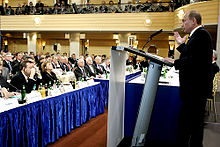
Vladimir Putin during his speech at the 2007 Munich Security Conference, in which he criticized the U.S. pursuit of a monopolistic world
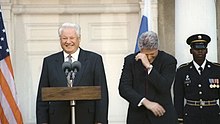
Boris Yeltsin and Bill Clinton 1995

Development of crime rate since 1960

Boris Kustodiev: The Bolshevik (1920)
.jpg)
Trotsky, Lenin and Kamenev

Bombed out Leningrad women leave their houses, December 1942
.jpg)
Tsar Peter I the Great, founder of the renewed Russian Empire
.jpg)
Dmitry Donskoi and the Emir of the Golden Horde Mamai defeated in the Battle of the Snipe Field - Scene of the National Monument A Thousand Years of Russia (1862)

Russia reached its greatest territorial expansion in the 19th century.
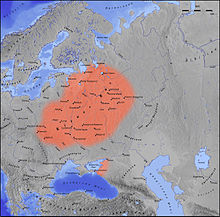
Kievan Rus at the turn of the millennium
Economy and infrastructure
→ Main article: Economic policy of Russia and Overall economic development of Russia.
General
Russia is a developed industrial and agricultural country. The country is also a founding member of the Eurasian Economic Union, which has existed since January 1, 2015. The leading industrial sectors are mechanical engineering and ferrous and non-ferrous metal processing. The chemical and petrochemical industry as well as the wood, light and food industry are also well developed.
Russia's gross domestic product was approximately EUR 1,192 billion in 2015. The gross domestic product per capita in the same year was EUR 8,137. The service sector contributes 62.6 percent to GDP. The industrial secondary sector accounts for about 32.7 percent, and the agricultural sector (construction and agriculture) for 4.7 percent. The World Bank estimated that about a quarter of total economic output is provided by commodity production.
According to a study by the bank Credit Suisse, the average wealth ownership per adult person in Russia is 16,773 US dollars. However, the median is only 3,919 US dollars (world average: 3,582 US dollars), which indicates high wealth inequality. More than 70% of the Russian population owns less than $10,000 in assets. Russia ranked 19th in the list of countries by total private wealth, one place ahead of Indonesia and one behind Sweden. In 2017, Russia was the country with the fifth highest number of billionaires (96 in total). The so-called oligarchs in the country have partly become a symbol of corrupt structures and inequality.
The total number of employees is 73.5 million (2006). 30 percent of the workforce worked in industry in 2005. Agriculture employed 10 percent, services 22 percent, and the public sector another 22 percent of all workers. In 2013, Russian Deputy Prime Minister Olga Golodez said only 48 million (down from 86 million) working people were visible to the government; depending on the estimate, the shadow economy accounted for half of economic output. Small and medium-sized enterprises contributed one-fifth, whereas state-owned corporations contributed 70 percent. Even pensioners who continued to work because of minimal pensions belonged to the army of self-employed small earners who hardly ever declared their income: Tax morale was at an all-time low in view of the politicians' well-known corrupt excesses.
After years of upswing, the Russian economy was in recession around 2015/16. After growing by 0.6% in 2014, the Russian economy contracted by 3.7% in 2015. For 2016, a decline in economic output of 0.2% was officially reported. The very low oil price, the fall in the value of the ruble and Western sanctions in the wake of the Ukraine crisis were cited as the main reasons for the recession. However, the Russian economy is also said to have fundamental structural problems. Furthermore, Russia had to contend with increased inflation rates of up to 15 percent in the case of 2015. Inflation fell again in 2018 to around three percent. In the Global Competitiveness Index, which measures a country's competitiveness, Russia ranks 38th out of 137 countries (as of 2017/18). In the Economic Freedom Index, the country ranked 114th out of 180 countries in 2017.
After the transformation crisis
Russia's overall economic development after the dissolution of the Soviet Union was initially characterized by a drastic slump in production. The loss of well-rehearsed trade relations within the Soviet Union contributed to this. The transition from a planned economy to a market economy was difficult and was successful only in some areas. Overall, gross domestic product fell by a good 40 percent. Shortly after the beginning of the Asian crisis, the Russian crisis began in the fall of 1997. On August 17, 1998, Russia declared state bankruptcy and had to abandon the ruble's dollar peg. The "policy of the minimal state" under Yeltsin meant that the federal government was unable to collect taxes and ensure legal security. This changed under the presidency of Vladimir Putin beginning in 2000. In order to regain political control in the state, he strengthened the state apparatus at the expense of the oligarchs' influence.
Putin ran a state-led corporatist economy in Russia until 2008. In 2007, he introduced by law six institutions to bundle state activities in strategically important areas, under the sole leadership of the president. These include nuclear technology at Rosatom, the bank for foreign trade VEB, the reform fund for real estate, Rusnano, or the arms conglomerate Rostec, plus Olimpstroi, the state company dissolved in 2014 for construction of the 2014 Sochi Olympics. VEB had emerged from the USSR's foreign trade bank. One of the things Prime Minister Medvedev criticized about these state conglomerates created by law was the use of state property or state funds for their creation, which led to hidden privatization. A 2009 audit of the corporations by Medvedev found abuse and inefficiency. President Medvedev, in his address to the nation in November 2009, called the organizational form of the corporations "without perspective." A few days later, Prime Minister Putin replied that state corporations were simply a necessity and stressed that there was unanimity on this among the state leadership.
The first four years of Putin's presidency saw the introduction of a flat rate for income tax (see Tax Law (Russia)), full convertibility of the ruble and a three-year budget (this until the financial problems in 2015). In order to benefit from the revenues of the energy sector, private companies were pushed back from this sector. The state also expanded its influence outside the energy sector. The government promoted the formation of large state-owned corporations to dominate strategic industries. For example, private mechanical engineering and automotive companies were taken over by state-owned enterprises and supported by subsidies so that they could be modernized.
Large production capacities from the USSR era were underutilized, so the Russian government turned to restoring these capacities to full capacity through a demand-oriented economic policy using expansionary, growth-oriented monetary policy. This brought double-digit inflation. The goal set by President Putin of doubling GDP within ten years was to be achieved by means of a government spending program. To this end, public sector salaries, pensions, other social benefits and spending on housing were increased. The social program was made possible by the oil boom, which, in addition to high additional revenues for the state, enabled a reduction in foreign debt, which still amounted to $166 billion in 2000. Part of the oil revenues flowed into the stabilization fund set up in 2004 to cushion declining government revenues and mitigate possible inflation. This stabilization fund was split into a reserve fund and a prosperity fund (for pension protection) in 2008. In 2011, the prosperity fund amounted to 68.4 billion euros, the reserve fund to 19.9 billion euros.
The Russian economy had recovered quickly from the production slump in the wake of the 1998 financial crisis, as the significant devaluation of the ruble that occurred in 1998 boosted the Russian economy and made foreign goods more expensive, so that products from Russia became more competitive there. In terms of foreign trade, however, the Russian economy became even more dependent on the energy sector. Despite a sharp rise in investment, Russia invested too little by international standards. Investors criticized the lack of legal security, widespread corruption, excessive bureaucracy and the poor performance of the Russian banking system.
In the international economic crisis
In the wake of the international economic crisis, the Russian economy has shown clearly negative developments since mid-2008, largely due to its heavy dependence on the raw materials sector. Due to the drastic drop in the price of oil and natural gas, government revenues fell. The global financial crisis hit Russia hard in 2009. Russia's anti-crisis policy prevented major bank collapses, so the Russian financial system is once again considered stable. Mandatory deposits with the central bank were increased, and banks received state aid. The Russian Central Bank used nearly $300 billion in reserves to support the ruble, which had come under devaluation pressure as a result of foreign capital withdrawals. In 2010 and 2011, an economic recovery began in Russia.
This crisis made it clear that the fixation on raw material wealth was leading the country into a dead end and that dependence on world market prices for oil, natural gas or metals was too high. Already at the beginning of the 21st century, an intensive discussion about special economic zones had begun in Russia. Under Vladimir Putin, a corresponding law on special economic zones was passed in the Russian Federation in 2005. By the end of 2009, 15 of these zones had been designed and confirmed, including two industrial special economic zones (Yelabuga, Lipetsk), four technology-oriented special economic zones (Moscow, St. Petersburg, Dubna, Tomsk) and seven zones for tourism and recreation. Interest rates were lowered to allow investment in production. The inflation rate reached its lowest level in 20 years in 2011. The government endeavored to keep price-driving factors such as the rise in the price of fuel and electricity under control via quarterly agreements with suppliers.
While the country was still the 22nd largest economy in 1999, in 2012 it ranked ninth in the world in terms of nominal GDP. While the value of Russia's GDP in relation to Germany's was 21.7 percent in 2004, it was already 51.7 percent in 2011. Accession to the World Trade Organization (WTO) took place in 2012 after 18 years of negotiations, as a result of which import tariffs fell and the pressure to modernize the domestic economy increased. In 2015, Russia's economic performance was again behind Italy's, ranking 10th or 11th. Until 2018, the government had never dared to raise the retirement age, which Stalin had set in 1932 - but pensions, which women receive from age 55, men from 60, are so low that many earn extra money in the shadow economy. At the same time, the labor market lacked workers.
Selected key figures of the Russian economy
| Year | GDP | GDP per capita | GDP growth | Inflation rate | Unemployment rate | Public debt | Budget balance | Trade balance |
| 1992 | 1.703,0 | 11.482 | k. A. | k. A. | 5,2 % | k. A. | k. A. | ▼−1,3 % |
| 1993 | ▼1.591,9 | ▼10.724 | ▼−8,7 % | ▲874,6 % | ▲5,9 % | k. A. | k. A. | ▲1,3 % |
| 1994 | ▼1.419,3 | ▼9.563 | ▼−12,7 % | ▲307,6 % | ▲8,1 % | k. A. | k. A. | ▲2,6 % |
| 1995 | ▼1.389,5 | ▼9.370 | ▼−4,1 % | ▲197,5 % | ▲9,4 % | k. A. | k. A. | ▲2,1 % |
| 1996 | ▼1.363,8 | ▼9.210 | ▼−3,6 % | ▲47,7 % | ▲9,7 % | k. A. | k. A. | ▲2,6 % |
| 1997 | ▲1.406,3 | ▲9.517 | ▲1,4 % | ▲14,8 % | ▲11,8 % | k. A. | k. A. | ▬0,0 % |
| 1998 | ▼1.345,6 | ▼9.130 | ▼−5,3 % | ▲27,7 % | ▲13,3 % | k. A. | ▼−7,4 % | ▲0,1 % |
| 1999 | ▲1.452,9 | ▲9.889 | ▲6,4 % | ▲85,7 % | ▼13,0 % | 92,1 % | ▼−3,6 % | ▲12,6 % |
| 2000 | ▲1.635,3 | ▲11.170 | ▲10,0 % | ▲20,8 % | ▼10,6 % | ▼55,7 % | ▲3,1 % | ▲16,3 % |
| 2001 | ▲1,757.7 | ▲12,054 | ▲5,1 % | ▲21,5 % | ▼9,0 % | ▼44,3 % | ▲3,0 % | ▲9,7 % |
| 2002 | ▲1.869,3 | ▲12.875 | ▲4,7 % | ▲15,8 % | ▼8,0 % | ▼37,5 % | ▲0,7 % | ▲7,4 % |
| 2003 | ▲2,046.7 | ▲14,156 | ▲7,3 % | ▲13,7 % | ▲8,2 % | ▼28,3 % | ▲1,3 % | ▲7,2 % |
| 2004 | ▲2,253.9 | ▲15,647 | ▲7,2 % | ▲10,9 % | ▼7,7 % | ▼20,8 % | ▲4,6 % | ▲9,2 % |
| 2005 | ▲2.474,8 | ▲17.232 | ▲6,4 % | ▲12,7 % | ▼7,2 % | ▼14,8 % | ▲7,6 % | ▲10,3 % |
| 2006 | ▲2.758,8 | ▲19.249 | ▲8,2 % | ▲9,7 % | ▼7,1 % | ▼14,8 % | ▲7,8 % | ▲8,7 % |
| 2007 | ▲3.073,9 | ▲21.473 | ▲8,5 % | ▲9,0 % | ▼6,0 % | ▼8,0 % | ▲5,6 % | ▲5,2 % |
| 2008 | ▲3,298.7 | ▲23,054 | ▲5,2 % | ▲14,1 % | ▲6,2 % | ▼7,4 % | ▲4,5 % | ▲5,8 % |
| 2009 | ▼3.063,8 | ▼21.411 | ▼−7,8 % | ▲11,7 % | ▲8,2 % | ▲9,9 % | ▼−5,9 % | ▲3,8 % |
| 2010 | ▲3.240,9 | ▲22.639 | ▲4,5 % | ▲6,9 % | ▼7,4 % | ▲10,6 % | ▼−3,2 % | ▲4,1 % |
| 2011 | ▲3.475,4 | ▲24.259 | ▲5,0 % | ▲8,4 % | ▼6,5 % | ▲10,8 % | ▲1,4 % | ▲4,7 % |
| 2012 | ▲3.670,4 | ▲25.592 | ▲3,7 % | ▲5,1 % | ▼5,5 % | ▲11,5 % | ▲0,4 % | ▲3,2 % |
| 2013 | ▲3.796,8 | ▲26.440 | ▲1,8 % | ▲6,8 % | ▬5,5 % | ▲12,7 % | ▼−1,2 % | ▲1,5 % |
| 2014 | ▲3.892,0 | ▲27.072 | ▲0,7 % | ▲7,8 % | ▼5,2 % | ▲15,6 % | ▼−1,1 % | ▲2,8 % |
| 2015 | ▼3.835,8 | ▼26.658 | ▼−2,5 % | ▲15,5 % | ▲5,6 % | ▲15,9 % | ▼−3,4 % | ▲4,9 % |
| 2016 | ▲3.877,0 | ▲26.930 | ▼−0,2 % | ▲7,1 % | ▼5,5 % | ▼15,7 % | ▼−3,6 % | ▲1,9 % |
| 2017 | ▲4.007,8 | ▲27.834 | ▲1,5 % | ▲3,7 % | ▼5,2 % | ▲17,4 % | ▼−1,5 % | ▲2,2 % |
After the annexation of Crimea in 2014
→ Main article: Russian economic crisis 2015
As a result of the sanctions imposed by the West due to Russia's annexation of Crimea and the war in Ukraine fed by Russia since 2014, economic development stagnated in conjunction with a collapse in the price of oil. The structural problems of the Russian economy, which had been geared to commodity exports for years, became accentuated. In August 2015, the NZZ wrote in a comparison with the ruble crisis of 1997: "Today the situation is less threatening, but the chances of improvement are lower"; thus, the ruble weakness could not be used to modernize and diversify the economy due to financial restrictions. Russian household income in 2015 fell by an average of 8.5 percent, while food prices rose by as much as 25 percent. Annual inflation in 2015 was 12.9 percent. A capital amnesty was supposed to bring money back to Russia starting in December 2014. While presidential spokesman Peskov spoke of an absolutely one-time offer valid for one year when it was introduced, the amnesty was extended to June 2016 in December 2015 and renewed in early 2018 following new U.S. sanctions.
All government spending had to be cut, only armaments were not affected. Russian Prime Minister Medvedev had repeatedly stated that the country would have to live with the Western sanctions "indefinitely." Economic development remained paralyzed because the Putin regime's techniques of staying in power prevented not only political but also economic reforms. The share of the state economy increased, the shadow economy flourished, and real incomes had fallen several times between 2014 and 2018. A tax rate of 0 percent for 2017/2018 should have encouraged self-employed workers to register their activities; of the presumably approximately nine million such workers, just 936 had registered. According to a renewed legislative proposal of 2018, these small earners were to be stripped of all their earnings if the activity was discovered, i.e. a harsher penalty than those earning good money would have to face. Opening a business was not desirable for the majority of Russians interviewed in February 2019, as it was not possible to do business without cheating. Foreign direct investment, which had totaled $69 billion in 2013, had fallen to well below $5 billion by 2018, according to Le Monde.
In July 2018, it was decided to increase the VAT by two percent, making it 20 percent from January 1, 2019.
Agriculture and raw materials management
Russia's natural resources are an important basis for the country's economy. Russia is home to 16 percent of all the world's natural mineral resources, including 32 percent of all natural gas reserves (first place in the world), 12 percent of all petroleum reserves, which are found in particular in Western Siberia, Sakhalin Island, North Caucasus, the Komi Republic, and the petroleum areas in the Volga-Ural region (Caspian depression). With the strong growth of oil exports with rising oil prices from 2002 to 2011, the importance of production especially of oil and gas in Russia had grown and played an important role in the economy outside Russia as well. Russian companies such as Gazprom, Rosneft and Lukoil are involved in oil and gas production, which mainly takes place in the northern and eastern parts of the country.
With its gold reserves, Russia ranks third in the world. The diamond deposits in the northeast Siberian region of Yakutia are world-famous. Since 1996, diamonds have been mined here in one of the world's largest kimberlite deposits, in Mirny.
Russia's share of world reserves of iron and tin is over 27 percent, nickel 36 percent, copper 11 percent, cobalt 20 percent, lead 12 percent, zinc 16 percent, and platinum group metals 40 percent. 50 percent of the world's known coal deposits are found in Russia. In line with mineral deposits, hard coal and iron ore mining play a very important role in Russia's economy. Larger ore deposits are found mainly in the old-folded mountains (Chibins on the Kola Peninsula, Urals, Altai, Sayan Mountains as well as other Siberian mountain ranges). Deposits of hard coal are found in some promontories of these ranges, mainly in the Urals (including coal deposits of Workuta) and in the Donets Basin on the border with Ukraine. Coal mining suffered from a lack of investment and has lost importance compared to the Soviet period.
The timber industry is mainly present in the northwest of the European part, in the central Ural Mountains, in southern Siberia and in the south of Far Eastern Russia. Russia has about one-fifth of the world's forest cover and about one-third of the world's coniferous forest cover; most of Russia's timber production is softwood, mainly from pines, firs, and larches. The most important hardwood for trade is birch.
Agriculture remains an important sector of the Russian economy. Once the breadbasket of Europe, Russian agriculture suffered a drastic slump in agricultural production in the 1990s - but as early as the 1980s, Russia was the world's most important importer of wheat. In 2009, the production value of Russian agriculture was again the equivalent of 38 billion euros. In 2016, President Putin underlined the will to be an agricultural export nation. Of the record wheat harvest of 75 million tons in 2016, nearly 7 million tons (similar to 2015) could be exported. The state agricultural transport agency Rusagrotrans is responsible for transportation. The value of exported agricultural goods was $17 billion in 2016. Conditions for agriculture are good, especially in the European part of Russia and in southern Russia; Russia's black soil area is the largest in the world. Agricultural land is 219 million hectares, or 13 percent of Russia's land area. Of this, 122 million hectares is arable land, which is nine percent of the world's arable land. More than 80 percent of the sown land is located along the Volga River, in the North Caucasus, in the Urals, and in Western Siberia within the so-called agricultural triangle. Arable farming accounts for 36 percent of Russia's gross agricultural production, and animal husbandry for over 60 percent. The main agricultural products in Russia are cereals, sugar beets, sunflowers, potatoes, and flax. Inland fisheries provide sturgeon, the coveted Russian caviar. During the transformation period between 1990 and 1997, pig and poultry stocks fell by almost half. Since then, Russia has imported some of its food. It was the Russian government's goal even before, but especially since its counter-sanctions against the West following the annexation of Crimea in 2014, to increase its ability to be self-sufficient and reduce its dependence on imports. The population of cattle is 12.1 million head, pigs 7 million, and sheep and goats 4.6 million. Cattle breeding is mainly carried out in the Volga region, Western Siberia, and the European center; pig breeding is also found in the Volga region, but also in Northern Caucasia and the Central Black Earth region. Sheep breeding is concentrated in the regions of Eastern Siberia, Northern Caucasia and the Volga region.
Energy supply
→ Main article: Energy industry of Russia
Thermal power plants fueled by oil, natural gas or coal generated around 63 percent of the total electricity production of around 851 billion kilowatt hours in 2003. Hydroelectric power plants accounted for 21 percent and nuclear power plants for 16 percent. The Russian government plans to double the share of nuclear power in electricity generation to about one-third by 2020 in order to be able to export even more oil and natural gas. The power grid and most large power plants are still under state control. In order to benefit from the revenues generated by the energy sector, Russian policy has been to reassert state control over the energy industry and to push back private companies from this sector. This was achieved through the breakup of the oil company Yukos and the takeover of the oil company Sibneft by the semi-state-owned natural gas company Gazprom. Among the largest gas and oil production companies today is Surgutneftegas, where President Vladimir Putin controls 37 percent of the shares. All Russian nuclear power plants are owned by the state-owned company Rosatom and operated by Rosenergoatom, also a state-owned company. Until 2008, the largest share of electricity production was held by Unified Energy System, which was more than 50 percent owned by the Russian state and has since been split into smaller companies.
Industry, services and foreign trade
In addition to the old industrial areas of Moscow, Nizhny Novgorod, Saint Petersburg, Saratov, Rostov and Volgograd, further industrial sites have been established since World War II, preferably in the Asian part of the country. Heavy industry is concentrated in the Urals around Ekaterinburg. Russia plays a leading role in the global production of steel and aluminum. In recent years, world-renowned steel groups with high financial strength have been formed in Russia. These are, for example, Evraz, Severstal, Magnitogorsk Iron and Steel Works and Novolipetsk Steel, which are among the world's 30 largest steel companies. Important centers of heavy industry are Magnitogorsk, Chelyabinsk, Nizhny Tagil, Novokuznetsk, Cherepovets and Lipetsk.
Numerous machine and vehicle industries produce in the old main industrial centers of Moscow, the Volga region, the Northwest and the Urals, but equipment and plant manufacturing is also located here. Several branches of manufacturing, such as machine building, the automotive industry and the defense industry, including the aviation industry, fell into a deep crisis after the end of the Soviet Union. Production declined sharply. In the 2000s, however, the manufacturing industry started to pick up again. Market shares were regained, especially in markets in the CIS, and new markets were found in Asia because some Russian products were able to distinguish themselves as simpler and cheaper than competing Western products. Domestic production of machinery and equipment reached a volume of around 63 billion euros in 2006. In order to push the necessary modernization in the machine building sector, the state controls the further development of machine building from above. This included the establishment of the state holding company Rostechnologii, into which state shares of almost 500 companies (defense companies, airlines, truck and railcar manufacturers and machine builders) were brought.
| Production of selected products | ||
| Product type | 2005 | 2011 |
| Iron ores | 82.5 million t | 100 million t |
| Coal | 299 million t | 335 million t |
| Pig iron | 66.2 million t | 48.1 million t |
| Oil | 470 million t | 511 million t |
| Natural gas | 641 million m³ | 670 million m³ |
| Cement | 48.7 million t | 53.7 million t (2008) |
| CAR | 1.068 million pcs. | 1.738 million pcs. |
| TRUCK | 0.204 million pcs. | 0.249 million pcs. |
| Power generation | 953 TWh | 1052 TWh |
Aircraft manufacturing was one of the most important and technically most advanced branches of Russian industry. After the breakup of the Soviet Union, the production chains between the former Union republics were interrupted. This had a profound negative impact on Russian aircraft manufacturing. The main developers and producers of aircraft in Russia were merged into OAK in 2006. In 2010, OAK delivered 75 aircraft with revenues of four billion U.S. dollars. The best known Russian car manufacturers are AwtoWAS, KAMAZ, Ischmash or the GAZ Group. Very often you can still see the Russian-made car brands Shiguli, Moskvich, Lada Niva and Oka, as well as the trucks KAMAZ, Ural and others. Meanwhile, Russian car manufacturers cooperate with foreign groups. Currently, Volkswagen Group Rus cooperates with GAZ, Ford with Sollers, Renault-Nissan and AwtoWAZ, and General Motors (GM) with Avtotor. As a result, new assembly plants have been and are currently being built in Kaluga, Nizhny Novgorod, Togliatti, St. Petersburg and Kaliningrad. Russia's defense industry is coordinated by the state arms exporter Rosoboronexport. Rosoboronexport coordinates the work of the various defense companies and combines them into a single group through shareholdings.
The chemical industry of Russia is one of the main branches of the national economy of Russia, the share of which in the volume of goods production reaches six percent. The chemical complex of Russia includes 15 large industrial groups specializing in the output of a diverse production. The leading enterprises in this sphere are the highly profitable, petroleum processing enterprises and producers of chemical fertilizers. In addition, the production of chemical fibers, plastics and car tires are strongly developed in Russia. Russia's economy is also characterized by the production of building materials, light industry (mainly textile industry) and food industry.
The leading local retail chains include, by a wide margin, the X5-Retail Group (which includes the Pyatyorochka and Perekryostok chains), Magnit; among the international chains, the Metro Group and Auchan lead the way. The banking market is dominated by state-owned institutions such as Sberbank, WTB, Rosselchosbank and Vneshekonombank. Sberbank alone, the former Soviet Union Workers' Savings Bank, holds about half of all savings deposits. Only Sberbank has a nationwide branch network. The share of state-controlled banks in the total market averages about 50 percent. The largest Russian private banks (Gazprombank, Alfa Group, MDM Bank, Rosbank) are part of industrial holding companies and perform mainly holding company functions.
In terms of supply structure, Russia's most important trading partner is Germany, which primarily supplies Russia with finished industrial products such as machinery, plant and cutting-edge technology. Russia, in turn, is Germany's largest supplier of crude oil and covers around one-third of Germany's natural gas requirements. German-Russian trade rose by 8.4% in 2018 to 61.9 billion euros. German imports from Russia increased by 14.7% year-on-year and amounted to around 36 billion euros. Exports to Russia also increased by 0.6% to 25.9 billion euros. In 2010, the People's Republic of China replaced Germany as the most important foreign trade partner, while the Netherlands, Ukraine, Italy, Belarus and Turkey are also important for Russia. Russia is already the world's second largest exporter of crude oil and the world's largest exporter of natural gas. Exports of energy sources and electricity account for 62.8 percent of total exports (metals, metal products: 9.9 percent, chemicals: 4.1 percent). Russia's share of global trade in goods, however, is comparatively small despite its significant position as a supplier of raw materials. It amounts to two percent, just under a third of Germany's share.
Russia's trade in goods with foreign countries was down in 2019. On a US dollar basis, trade turnover fell by 3.1 percent year-on-year, amounting to the equivalent of around 595 billion euros. Imports of goods and services increased by 2.2 percent, while exports declined by 6 percent. For the first time in ten years, exports thus put the brakes on GDP growth.
Tourism
→ Main article: Tourism in Russia
Tourist highlights of Russia
The country has natural landscapes worth seeing, including UNESCO World Natural Heritage sites, as well as sights of high cultural value. In 2010, 2.4 million foreign tourists visited Russia, while 13.1 million Russians traveled abroad for recreation. Domestic tourism brought it to 29.1 million travelers. Although the flow of tourists from Asia and South America is increasing, guests from Europe - with Germany in the lead - make up the majority of visitors to Russia. Thus, the number of vacation and business travelers entering the country has also risen steadily; in 2002, around 360,000 Germans visited the country; in 2008, 558,000 German visitors came to Russia. However, only 66,000 of these were vacation trips by Germans and the rest were business trips and family and friend visits. In 2017, 580,000 Germans visited the Russian Federation. Individual tourists were often deterred by visa procurement and language barriers, while the country is more popular with tour groups.
Tourists have long been put off by an unattractive brand image that "Russia is an uneasy country" and "not ready to receive tourists. That the people there are unfriendly and that danger lurks all around," Alexander Radkov, head of the state tourism agency Rostourismus, opined in 2012. Despite increased activities by the Federal Tourism Agency, an effective PR and marketing strategy that could influence the country's poor image in the West, caused among other things by media coverage that mainly includes news about attacks, corruption and lack of freedom, is still lacking.
Tourism in Russia is mainly concentrated in the two metropolises of Moscow and Saint Petersburg. Saint Petersburg is considered the Venice of the North and has a rich cultural offering and a historic city center that is a UNESCO World Heritage Site in its entirety. Typical of St. Petersburg are the White Nights with the raised Neva bridges from late May to mid-July. In addition, there are boat trips on the Volga River and sightseeing tours of ancient Russian cities northeast of Moscow, the so-called Golden Ring with more than 20 cities. Nature vacations are possible especially in Karelia and the Altai Mountains (World Natural Heritage). The Trans-Siberian Railway (Transsib) covers about 9300 kilometers from Moscow via Ekaterinburg, Novosibirsk, the capital of Siberia, Irkutsk, which is also called the "Paris" of Siberia, as well as the region around Lake Baikal, also a UNESCO World Natural Heritage Site, to Vladivostok. The Transsib is traveled by individual tourists in the regular trains of the Russian railroads as well as by group travelers who book trips in special trains.
Kaliningrad, formerly Königsberg, is also attracting more and more German visitors. The Curonian Spit, a narrow headland declared a UNESCO World Heritage Site in 2000, lies partly in the Kaliningrad Oblast and partly in Lithuania.
In terms of internal Russian tourism, the seaside resorts of the Black Sea coast as well as a number of North Caucasian thermal spring resorts such as Kislovodsk or Pyatigorsk are important. 400 kilometers lie between the northernmost and southernmost points of the Russian Black Sea coast. On this relatively small stretch of coast, located on the same latitude as the seaside resorts of the Adriatic Sea and the Italian and French Mediterranean coasts, the majority of Russia's seaside resort activity is concentrated within the season from May to October.
Ski tourism is becoming increasingly popular in the North Caucasus. Especially for the 2014 Winter Olympics in Sochi, the corresponding infrastructure was expanded.
Transport infrastructure
With a size of 17,075,400 km², the country's special focus is on having the most diversified and functioning infrastructure possible. After Russia's political transition, the volume of traffic had initially decreased for the most part due to economic downsizing, but then experienced strong growth. Much of the current infrastructure still dates from Soviet times and is now in need of modernization, and the existing transportation systems generate little network effect. The expansion and modernization of the transportation infrastructure is therefore a high priority for the Russian government. In 2005, the government adopted a strategy for the renewal of transport routes, focusing on continued modernization and improvements in rail, road and air transport, as well as the rehabilitation of the country's ports. In addition, concessions and other public-private partnership models in the transport sector are to be stepped up in order to mobilize financing from private investors in this sector as well.
Despite difficult conditions, Russia programmatically wants to establish itself as an important hub in Asia-Europe traffic and to some extent also on the north-south axis from northern Europe to India. To this end, the logistics infrastructure is to be expanded, especially at the Moscow and St. Petersburg hubs.
While Russia's transport infrastructure west of the Urals is generally well developed, the infrastructure of road and railroads in the Trans-Ural and Siberia is technically obsolete at best and not competitive. The biggest transportation obstacle to linking the vast territories of Siberia economically to the booming South and Southeast Asian states is the lack of transport routes in the north-south direction. Accordingly, Vladimir Putin and Xi Jinping agreed in 2015 to integrate the Eurasian Economic Union, initiated respectively by Russia and China, and the Silk Road Belt Initiative into one project, the Central Eurasia Initiative. The aim is to develop a logistical strategy for a new transport framework for Siberia and Russia's Far East.
In the Logistics Performance Index, which is compiled by the World Bank and measures the quality of infrastructure, Russia ranked 75th among 160 countries in 2018.
Railroad
As a means of mass transportation over long distances, the railroad occupies an important part of the transport market in Russia. Due to the long distances, the connection of the Far East was a great challenge in the early 20th century, which the country was able to establish with the famous Trans-Siberian Railway. In parallel, at the end of the 20th century, in order to open up the Far East of Siberia, the Baikal-Amur Highway was built from Lake Baikal to the Amur River. These two and the branching routes open up the country in a west-east direction. They will make it possible, for example, to reduce the transport of goods between Pusan and Helsinki from about 47 days by sea to about 16 days.
In May 2001, the Russian government decided to implement the railroad reform. The main objectives were the liberalization of the railroad market and the liberalization of railroad tariffs. As part of the railroad reform, the former Ministry of Railways (MPS) was dissolved in October 2003 and Russia's second largest state-owned company, Rossiyskiye schelesnyje dorogi (RZhD), was established. In recent years, Russia has also seen the emergence of 85 private rail companies, which now transport more than 25 percent of freight and own about 30 percent (about 200,000 freight cars) of the total freight car fleet in Russia. The rail network in Russia is operated by RZhD. In total, the well-developed rail network (broad gauge with 1520 millimeters) covers about 87,000 kilometers, of which just under half (40,000 kilometers) is electrified. On Sakhalin Island, there are almost 1,000 kilometers in 1067 millimeter gauge. In addition, there are 30,000 kilometers of non-public industrial railroads (all figures 2004). Whereas in Western Europe road haulage has been the dominant mode of transport for decades and rail has been of secondary importance, trucks have only been able to catch up in Russia since 2000. As a result, rail has an above-average market share of 83 percent of freight traffic in Russia.
Road traffic
Since 2000, there has been a clear trend toward roads in Russia. Road density is very low at 40 meters of road per square kilometer. This is partly due to the very low population density in large parts of the country. The road network in Russia is of very variable quality, and its expansion cannot keep pace with the ever-increasing road traffic. The density of the network decreases sharply from west to east: the further east one moves from Moscow, the more road conditions deteriorate. Nevertheless, the majority of freight traffic between Western Europe and Russia is carried by road - in transit via Poland and Belarus or via the northern route via Poland and the Baltic republics as well as via Finland. The difference in the gauge of the railroads also contributes to this.
The Russian highway and trunk road network comprises a total of about 540,000 kilometers (2001), two-thirds of which are paved. Only since 2003 has there been a spatially and seasonally continuous road connection from the Baltic Sea to the Pacific Ocean. Outside of urban areas, the trunk roads are generally not developed as highways or expressways, and even on larger wide roads, the directional lanes are not separated by guardrails. The most important trunk road in Russia is the European Road 30, which ends in Siberia.
The share of transport costs in production costs is up to 20 percent due to the poor roads. The poor infrastructure costs the country up to nine percent of its economic output; transport experts estimate that the equivalent of at least 32 billion euros would have to be invested annually in expanding the roads.
A relatively large number of fatal accidents occur on the roads. In 2013, there were a total of 18.9 traffic fatalities per 100,000 inhabitants in Russia. By comparison, in Germany there were 4.3 fatalities in the same year. This means that a total of 27,000 people lost their lives in road traffic. The country's motorization rate is in the upper middle range worldwide. In 2017, there were 324 motor vehicles per 1000 inhabitants in the country. With around 46.9 million vehicles, Russia has the fifth-largest vehicle fleet of any country.
Shipping
Russia has a considerable number of ports and navigable waterways. 72,000 kilometers of inland waterways in the European part of Russia connect the Baltic Sea, the Black Sea, the inland lakes and the White Sea. Important waterways in this regard are the Volga, the Kama, the Nizhny Novgorod Oka, the Vyatka, the Don and the canals connecting these rivers.
In Siberia, 24,000 kilometers are navigable. Due to the drainage of the major rivers Ob, Yenisei and Lena into the Polar Sea, there is no east-west access by water; due to ice formation, the polar route is only possible for a few months in summer, but this period is being extended by climate change. The navigability of rivers and canals is severely impaired by meteorological influences (water level) and inadequate development. Since 1990, a reduction in the number of inland waterway vessels has been observed in Russia. In 2002, the number of inland vessels was still about 8800, of which 8000 were cargo vessels and 800 passenger vessels. The most important Russian inland ports are Arkhangelsk, Perm, Yaroslav, Saratov and Cheboksary.
Maritime shipping is one of the fast-growing transport sectors in Russia. The main reason for this is the increasing export volume of crude oil and petroleum products. The most important seaports are located in St. Petersburg and Kaliningrad on the Baltic Sea, Novorossiysk and Sochi on the Black Sea, and Vladivostok, Nakhodka, Magadan and Petropavlovsk-Kamchatsky on the Pacific Ocean; Murmansk is the only (North) Atlantic port kept ice-free all year round. In 2003, cargo throughput in Russian ports amounted to 285.7 million tons. Ferry traffic is important for freight traffic between the Russian heartland and the exclave of Kaliningrad.
Aviation
In Russia and the Soviet Union, aviation was of great importance from an early stage due to the country's surface area. National air traffic connects remote areas that were never worth reaching by land. In the Soviet era, the state-owned Aeroflot was the largest airline in the world and its fares were sometimes cheaper than those of the railroads. Tickets to Russia's Far East are still subsidized by the state today. In addition to the still semi-state-owned Aeroflot, the larger airlines are Rossiya, S7 Airlines and UTair, which are also affiliated with the state. The number of airports in Russia decreased from 1302 to 496 between 1992 and 2011, with the number of international airports increasing from 19 to 70 and 55 airfields having a paved runway longer than 3,000 meters. Several international airlines fly to other Russian cities besides Moscow. The largest and most important airports are Sheremetyevo-2 and Domodedovo near Moscow. In 2011, Russia's aircraft fleet comprised about 6000 aircraft, of which nearly 2000 were cargo planes. Government support and regulations serve to stimulate Russia's aviation industry. In the fall of 2018, the government awarded banks Sberbank and VTB a contract to establish a major regional airline, With their help, the upgrade of regional airports should be achieved to relieve the Moscow hub. In January 2020, President Putin instructed the government to form a company to develop the remote eastern regions with a fleet consisting entirely of Russian aircraft. This company was created on the basis of Red Wings.
Public transport
Almost half of passenger transportation is by local transport, mainly via the bus network, which exists in 120 cities. In addition, 90 Russian cities have a trolleybus network, 66 cities have streetcars and suburban trains, and seven cities also have a subway and four others have commuter rail lines.
In the 1990s, many of the good local transport networks fell into disrepair and were increasingly supplemented or replaced by private bus or regular taxi services. Also more recently, streetcar or trolleybus systems in several major cities have been decommissioned in favor of buses (for example, the trolleybus in Arkhangelsk and the streetcar in Ivanovo in 2008, or the streetcar in Voronezh in 2009).
Aerospace
In the 1990s, Russian spaceflight suffered from major funding problems, so that many programs came to a standstill. With the improvement of the economic situation, Russian spaceflight has been able to recover. Roskosmos, the state-owned enterprise, is the national space agency responsible for the country's civil space program; its headquarters are in Star City near Moscow. It was established as an agency in 1992 and took over the essential resources of the Soviet space program. Roskosmos currently uses three spaceports: the Plessezk Cosmodrome near Arkhangelsk, the Vostochny Cosmodrome in the Amur region, and the Baikonur Cosmodrome in Kazakhstan, the main base for Soviet and Russian spaceflight. Russia has been one of the most successful providers of commercial rocket launches for decades.
In July 2005, a new space program for the years 2005 to 2015 was approved by the Russian government. The goal was to secure the world level of Russian spaceflight and consolidate Russia's position among the world's leading space powers. Priority was given to the development and exploitation of space technology and services and the construction of spacecraft for manned flights, transportation and interplanetary missions, including a reusable space system. Russia is a major participant in the ISS, which, since the cancellation of the space shuttle program, has increasingly used the Soyuz rocket with the Soyuz spacecraft and the Progress space transporter to supply it.
Furthermore, the scientific and technical basis for a manned flight to Mars and a new-generation space station is to be created. As a first step, Russia wanted to bring its satellite fleet up to world standards by 2015, primarily with the help of Western elements. In addition, the first unmanned launches with modernized versions of the previous launch vehicles were to take place from the new Vostochny cosmodrome in the Amur region at that time. In fact, the older Soyuz-2.1 model has been launching there since 2016, and the first manned launches of spacecraft with the new Angara A5 launch vehicle were planned for 2020 from Vostochny; this is postponed until the mid-2020s. At the same time, missions for in-depth exploration of the moon as well as the planet Venus are planned for the 2020s.
The Russian space industry had been intertwined with that of Ukraine since Soviet times; several rockets, such as the Dnepr and the Zenit, were jointly developed and produced. The war with Ukraine broke up this cooperation, causing Russia to lose about half of its selection of launch vehicles. New indigenous developments such as the Soyuz-5 and -6 are expected to compensate for this during the 2020s.
Communication infrastructure
The history of the Internet in Russia begins in September 1990, when the top-level domain ".su" was registered for the then Soviet Union. This domain is partly used by Russian websites until today. In March 1994, the official top-level domain ".ru" was registered for Russian Internet addresses. Websites under this domain make up a considerable part of the Russian Internet - often called Runet for short. Meanwhile, the country also has a Cyrillic top-level domain (.рф). The Russian Internet segment ranked fourth worldwide around 2012, with a total of more than 3.6 million domain names.
In the 2000s, the number of Internet users rose steadily throughout Russia: While in 2000 there were only 3.1 million users (2.1 percent of the population) nationwide, by 2007 their number was already 28 million (19.5 percent). With more than 50 million Internet users, Russia became the European leader in 2011. In 2016, 102 million Russians used the Internet, or 71.3 percent of the population. Runet's most significant Internet projects include the search engines Rambler and Yandex, the online network W Kontakte, and the information and news portals RBC Informations Systems, Lenta.ru, and Gazeta.ru. The best-known providers include major telecommunications companies such as CenterTelekom, MGTS, North-West Telecom and VolgaTelekom. In the wake of government support for Internet expansion, social media activities in Russia experienced an exceptionally strong upswing, and corresponding platforms play a significant role in Russia. The Russian platforms Vkontakte.ru and Odnoklassniki.ru are particularly popular, with higher growth rates than international platforms such as Facebook. LiveJournal was also used more than average in Russia by international standards and, finally, Russian. The gross reach of social networks in 2010 was 49.2 million people living in Russia. Since then, many regulations with vague wording have been enacted, allowing authorities to crack down on services and users. From 2018, all communication content would have to be stored (and made available to the state); a postponement of this obligation by 5 years had to be considered in 2017 due to the effort involved.
Most of Russia's postal services are handled by the state-owned company Potschta Rossii. This was spun off in 2002 from the Federal Ministry of Posts and Telecommunications, which was also responsible for postal traffic in Soviet times. Today, Pochta Rossii offers its services in a total of over 42,000 post offices, which are distributed throughout Russia. The number of employees in the company is around 415,000 across Russia. Since the beginning of the 21st century, post offices in many cities have been offering not only basic postal services - such as sending and receiving letters, parcels and telegrams, and postal giro - but also complementary services, including public computer workstations with Internet access.
In the mail delivery sector, Potschta Rossii is the monopolist in Russia. In the parcel mail sector, internationally active courier companies such as DHL and TNT Express have also been operating in Russia since the 1990s.
The all-Russian telecommunications company Rostelekom is the largest company in this sector in Russia. Since April 1, 2011, it has included the regional branches Dalny Vostok (Far East), Sibir, Ural, Volga, Yug (South), Severo-Sapad (North-West) and Central (Center). The mobile communications market is mainly shared by the country's three largest providers Mobile TeleSystems, Beeline and MegaFon, as well as a number of smaller regional providers. This sector experienced rapid growth in Russia from 2000 onward: While less than one percent of the Russian population owned a cell phone in 2000, the nationwide number of cell phones exceeded the population figure in 2006 and amounted to a good 155 million as of March 31, 2007.
In 2019, the law stipulated that Internet data traffic must be routed via the company's own servers, thus ensuring independence from foreign countries from now on.
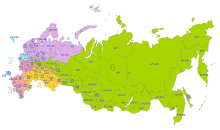
Russian postal code system (postal code map)
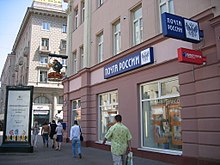
Post office on Arbat in Moscow

The Soviet space station Mir

Sovkomflot LNG tanker in Yuzhno-Sakhalinsk

View of Sheremetyevo Terminal-D
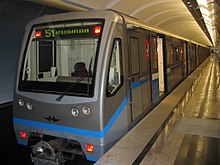
A train of the class 81-740/741 at the station Meshdunarodnaya, line 4 of the Moscow Metro

Murmansk port
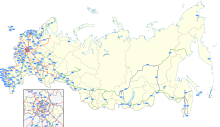
Trunk road network of the Russian Federation
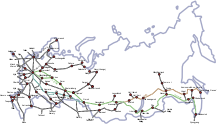
The main lines of the Russian Railways (Rossiyskiye schelesnyje dorogi, RŽD)

Sapsan high-speed train (almost identical in construction to the ICE 3) on the Saint Petersburg-Moscow railroad line

Course of the medieval Via Regia and Via Imperii in Europe
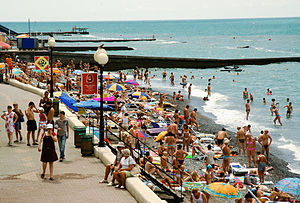
The Black Sea coast in Sochi
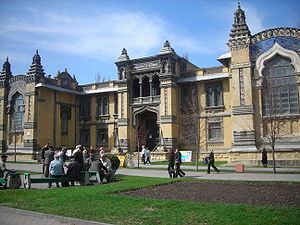
The Stavropol region in the northern Caucasus has several Russian-known spas with a large number of spa buildings, some of which date back to the 19th century, due to its wealth of medicinal and thermal springs.
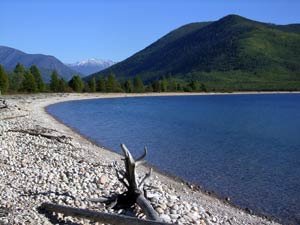
Since UNESCO included the Baikal region in the World Heritage List in 1996, the interest of tourists in Lake Baikal has been growing. Lake Baikal, also called "The Pearl of Siberia", is as interesting for adventure vacationers as it is for divers, mountain hikers, cyclists or people looking for recreation. The organization Great Baikal Trail tries to promote ecotourism by building a hiking trail around Lake Baikal. Pictured is the Frolikha Adventure Coastline Track.
_11.jpg)
The "Golden" Ring ("Golden" because of the golden domes) of ancient Russian cities northeast of Moscow is one of the most famous destinations in Russia. Hardly any longer Russia study tour can do without at least one trip to the Golden Ring. The ring gives visitors an insight into the history of the formation of Russia, which was significantly shaped from here.
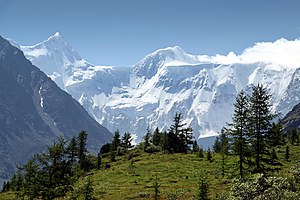
The Altai region offers an active vacation in almost untouched nature. Possibilities include several days of hiking and horseback riding, fishing, hunting, rafting, paragliding, etc. In 2008, more than 1 million people from over 60 countries visited the Altai region.
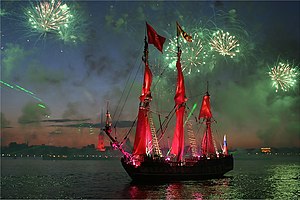
Fireworks during the graduation festival Scarlet Sails on June 20. It is considered the main event and highlight of the White Nights. With the support of the state, the city and television, the festival has become a major event on the scale of the Love Parade.

Transsib express train somewhere between Omsk and Novosibirsk.

Solovetsky Monastery is one of the most important centers of Orthodox Christianity in the Russian North. In its long history, the monastery, located on the Solovetsky Islands in the White Sea, experienced numerous sieges and eras.
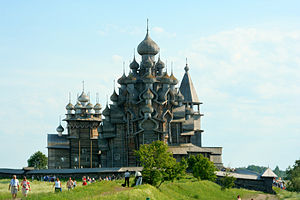
Kischi Island is an island in Lake Onega in Russia. Its ensemble of wooden churches, called the Kischi Open Air Museum, has been a UNESCO World Heritage Site since 1990. It currently includes about 80 buildings of Karelian wooden architecture.
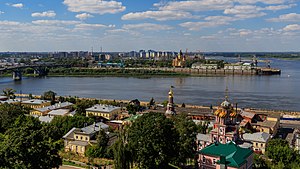
The spit of Nizhny Novgorod, known as the merger of the Oka and the Volga. On the spit is the Alexander Nevsky Cathedral and Mass. On the other bank of the Oka is a Church of the Nativity.
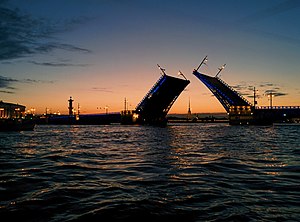
At night in St. Petersburg between 2 and 5 o'clock the Neva bridges are opened, whereupon there is no connection between numerous parts of the city. During the White Nights from late June to mid-July, the passage of the convoys of ships is a spectacle that thousands of people watch despite the time of night.

Peter's summer residence Peterhof Palace, the Russian Versailles: Great Cascade, in the background the Gulf of Finland
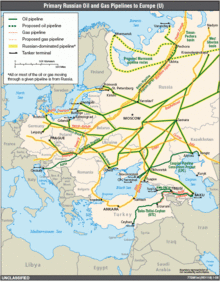
Many of the EU member states have no small dependence on Russian natural gas and oil supplies
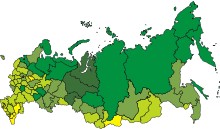
Russian GDP/capita by region (2006): > 400.000 rubles 150,000 to 400,000 rubles 100,000 - 150,000 rubles 50,000 - 100,000 rubles < 50,000 rubles

Wheat harvest in Rostov oblast

Can with 113 g Russian caviar
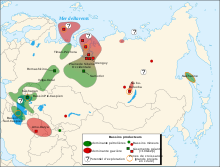
Map of major Russian oil and gas deposits

The Udachnaya diamond mine (aerial photo)

The new Russia: Moscow City, construction phase May 2010

Industry in Volgograd oblast
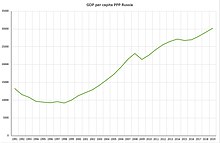
Recent Development of Russia's GDP per Capita (Purchasing Power Parity)
Health and social
Healthcare
See also: List of Russian Federation Subjects by Life Expectancy
Article 41 of Russia's constitution guarantees all citizens the right to free basic medical care. This principle, which has existed since Soviet times, is partly the reason why Russia has a comparatively high number of doctors and hospitals per capita by international standards. Nevertheless, the health condition of the Russian population is poor. Especially during the economic decline of the 1990s in Russia, the health care system was hit hard. As a result of extremely low wages paid to doctors and nurses, medical care for the general public deteriorated massively. For example, every third clinic of the 7000 hospitals in the country is now in urgent need of renovation. Salaries for medical personnel have been raised step by step recently, and state funds have been invested in the establishment of new clinics and the modernization of existing ones. Between 1999 and 2003, total spending on the health sector in Russia averaged 5.70 percent of GDP.
In Russia, the healthcare sector is organized on a decentralized basis. The Ministry of Health is responsible for the entire sector at the federal level. However, specific medical services (including the provision of hospitals) are the responsibility of the federal subjects and municipalities, which account for around two-thirds of total budget spending. The Russian health care system is financed by a mix of budget funds and funds from social insurance. Deteriorating relations with the West were followed by restrictions on the admission of medical equipment from abroad starting in 2015.
| Key figure | 2000 (according to Rosstat) | 2010 (according to Rosstat) | Change |
| Births in thou. | 1267 | 1790 | +41,3 % |
| Deaths in thou. | 2225 | 2031 | −8,7 % |
| Natural decrease in population in thou. | 959 | 241 | −74,9 % |
| Infant mortality in thou. | 19,3 | 13,4 | −30,6 % |
| Life expectancy in years | 65,3 | 69 | +5,7 % |
| Suicides in thou. | 56,9 | 33,3 | −41,5 % |
| Alcohol poisonings in thou. | 37,2 | 14,4 | −61,3 % |
| Abortions per 100 births | 168,8 | 66,3 | −60,8 % |
Statistical key figures in the area of health and social affairs
| Life expectancy (2010)* | 69.0 years | |
| Life Expectancy (Men) (2010)* | 63.0 years | |
| Life expectancy (women) (2010)* | 74.9 years | |
| Infant mortality (2010)*. | 7,5 from 1000 | |
| Infant mortality (2004) | 2,1 % | |
| Maternal mortality (2005)** | 28 / 100,000 Geb. | |
| Doctors* | 4.9 / 1000 Inhab. | |
| Hospital beds* | 10.7 / 1000 Inhab. | |
| Access to clean drinking water (according to WHO criteria)**. | 88 % (country); 100 % (city) | |
| Birth rate (2010)* | 12.6 / 1000 Inhab. | |
| Mortality (2010)* | 14.3 / 1000 Inhab. | |
| Suicides (per 100,000 inhabitants)*. | 23,5 | |
| Population growth (2009) | +0,008 % | |
| Fertility (2009) | 1.54 children / woman | |
| HIV infection rate (2005)** | 0,78 % | |
| HIV/AIDS infected (2015) | 986.657 | |
| Public expenditure on health (1997) | 4.6 % of GDP | |
| Public expenditure on pensions (1996) | 5.7 % of GDP | |
| Public spending on education and training | k. A. | |
| Compulsory education | 7-18 years | |
| Illiteracy rate (2002) ** | 0,6 % | |
| Poverty rate | 13,0 % | |
| Child Malnutrition | 3 % | |
| Source: Rosstat (*); WHO (**) | ||
Poverty
After the collapse of the USSR, poverty rose to over 40 % of the population by 1999 and then fell noticeably. In 2002, the share was 19.6 %, and by 2011 it had fallen to 12.8 % of the population, or 18 million Russians. Officially, the subsistence minimum was 170 euros for a person of working age; for children, the figure is insignificantly lower, and for pensioners it is 125 euros. The standard of living improved very differently from region to region. While some neighborhoods in Moscow and St. Petersburg in particular began to shine in new splendor, poverty remained high in other regions. In Chechnya and Dagestan, more than half of the people lived in poverty; other poor regions included Ingushetia, Tuva and Kabardino-Balkaria, Mari El, Kalmykia, Buryatia, and Altai and Mordovia. In 2011, the average wage was €576 per month. The large income disparities were reduced from 2005, and the middle-income stratum in particular increased significantly in percentage terms. In 2010, pensions were above the subsistence level for the first time in many years and, according to forecasts, should rise to €268 by 2014. In 2012, about half of the population belonged to the low-income stratum, which is unable to finance key social needs such as housing or additional education. In fact, in 2014, the average pension was 10,000 rubles, equivalent to 160 euros. Pensions and salaries had to be frozen. Since 2014, money from the second, funded pillar of the pension system has been used to cover financial needs.
Reducing poverty was among one of President Putin's five-year goals in the spring of 2019: nearly 19 million Russians were considered poor, representing 12.9% of the population.
The poorer sections of the population suffered from double-digit increases in consumer prices until 2009, which decreased again until 2012. Real income declined from 2014 to 2019.
The unemployment rate had begun to fall when the financial crisis was overcome in 2008. In growth regions such as Moscow, Kaluga and St. Petersburg, unemployment tended toward zero. Calculated according to International Labor Organization standards, unemployment was 7.1% in 2005, 7.6% in 2010 and 6.6% in 2011. By 2014, it fell to 5.2% and began to rise again. Unemployment benefits were between 60 and 70 euros per month. However, unemployment is a problematic indicator of the state of the economy due to a peculiarity of Russian labor law: layoffs for operational reasons are mostly inadmissible in Russia; instead, employers are allowed to unilaterally reduce labor compensation. For this reason, Russian employees prefer to remain in their jobs even when there is a lack of orders and accept high wage losses instead of claiming the rather symbolic unemployment benefits of 20 to 110 euros in 2019.
In the United Nations Human Development Index, Russia ranked 49th in 2016, with a score of 0.8 (out of 1) and a Gini coefficient of 37.7.
Environmental protection
→ Main article: Russian measures in climate policy
At the time of the Soviet Union, Russian nature was heavily polluted: littered with factory waste, chemically and radioactively contaminated. Even today there are serious environmental problems in Russia - but also a growing environmental awareness among the population. The citizen's right to a healthy environment and reliable information about its condition is enshrined in Article 42 of the Russian Constitution. However, environmental protection has a comparatively low priority in Russian politics, which is repeatedly criticized by international environmental organizations such as WWF or Greenpeace. In the past, for example, common environmental standards were often insufficiently observed in the development of new oil or natural gas deposits. A well-known recent example is the development of the Sakhalin II production area, where environmental regulations are said to have been violated to a greater extent. In addition, there is widespread corruption within state environmental authorities, allowing multiple violations of environmental regulations in the construction of houses or mass illegal logging. A large number of legacy sites from the Soviet era, including dilapidated factories that cannot meet today's environmental standards, also significantly pollute the environment in parts of the country. Some cities with such factories, such as Norilsk or Dzerzhinsk, are considered ecological disaster areas.
The more the quality of life will increase, the more important and urgent environmental issues will be discussed in Russia's public and political spheres in the future. Since 2004, sporadic efforts by the Russian state to advance environmental and climate protection have become visible. In Russia, for example, ratification of the Kyoto Agreement was completed on November 5, 2004, with the President's approval of the State Duma's decision. On January 30, 2008, President-elect Dmitry Medvedev expressed support for rapid development of the domestic market for innovation technology in environmental protection. Meanwhile, there are government plans to increase energy efficiency in Russia to limit the significant loss of thermal energy for the residential sector.
.jpg)
Bikin National Park in the Russian region Primorye
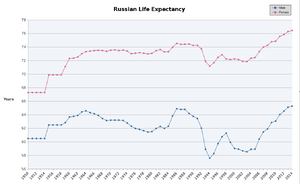
Development of life expectancy
Education and science
The first beginnings of scientific activity in Russia date back to the times of Kievan Rus. The first surviving chronicles, the Nestor Chronicles, date back to 1070, in which historical events and meteorological observations were recorded.
However, science as a social institution did not emerge in Russia until the beginning of the 18th century under the reign of Peter the Great. It was at this time that the first scientific institutions of the Russian Empire were founded, most notably the Academy of Sciences in 1724. In 1755, Russia's first university, now Lomonosov University, was founded in Moscow. In 1916, there were about 100 institutions of higher education throughout Russia, including 10 universities, as well as several dozen research institutions. Thus, the science of the Russian Empire was at a low level of development compared to many other European countries. Nevertheless, even at that time certain areas of Russian science enjoyed international prestige. Thus, among the first Nobel Prize winners were two Russian academics, Ivan Pavlov (1904) and Ilya Metschnikov (1908).
Russian science received a considerable boost in development during Soviet times. The Soviet Union as a whole had a well-developed research and development system. Characteristic of this period was the high degree of centralization of research. Thus, most scientists were employed by the Academy of Sciences or in its regional departments. Central features were the separation of research and production, the dominance of the Academy of Sciences of the USSR in basic and applied research, and the low importance of the university sector in research. All enterprises in the economic sector were state-owned and conducted little research themselves. Much of the research was done by specialized research institutes, which were generally organizationally separate from state-owned enterprises. Because the Soviet state gave very high priority to industrialization and military superiority, it was particularly generous in promoting research and development in these areas. After the end of World War II, the state promoted the development of Soviet spaceflight very intensively. All this led to the Soviet Union's emergence as an industrialized country in the second half of the 20th century. Its research and development was considered a world leader in certain fields, such as the defense industry and space travel.
Education system
→ Main article: Education system in Russia
The education system in Russia is divided into four sections: general school education, vocational education, higher education and postgraduate education. General school education does not mean that the child must attend school. At the request of parents, a child can receive home education if his level of knowledge corresponds to the school program, which is checked twice a year. This right is guaranteed in Russia by the State Constitution (the Article 43), as well as by the Federal Law №273-ФЗ (the Federal Law on Education in the Russian Federation).
General school education is again subdivided into the basic level, main level and upper level sections.
- Basic level: School entry takes place at the age of seven. Both the academic year and the school year begin uniformly throughout Russia on September 1 of each year. The early school entry age of six is recommended for an average of about 35 percent of children after a psychological evaluation. Children who start school at the age of seven complete the four-year primary level of elementary or initial school within three years. In this way, they move from the third to the fifth school year immediately.
- Hauptstufe: This is followed by a compulsory six-year Hauptschulstufe. It leads to the acquisition of "basic general education" - usually at the end of the ninth grade and after reaching the compulsory school age of 15. This qualification entitles the student to attend upper secondary education (two years). After completing nine years of compulsory education, students can also pursue vocational training at the intermediate technical school (Berufsschule) or the technical college instead of the upper secondary level. These institutions continue to be available in the vertically permeable overall vocational education system for the acquisition of the complete intermediate education (dual training course). This is because, in addition to the occupation-specific subjects, the general education subjects are also taught, although their content is oriented toward the occupation.
- Upper secondary school: Upper secondary school is completed with the "certificate of complete intermediate education" (traditionally known as the "Reifezeugnis") - in German Abitur, but this does not yet guarantee university entrance. This requires a demanding entrance examination. Those who have passed the Abitur with very good results only have to pass one or two entrance exams. In the case of poorer Abitur grades, several subjects are examined.
For higher education, students in Russia have a diverse higher education system at their disposal. In addition to the classic university with a broad range of subjects, there are various colleges and academies with a special technical, pedagogical or economic focus. Although the Abitur is a prerequisite for attending university, students must also pass an entrance examination. Financing of studies is free of charge for high-achieving students, but for an ever-increasing part of the population it is only fee-financed. Universities were given greater rights to self-government after 1992. Universities are being reorganized; venerable institutions are given new names and modern structures.
The duration of most study programs is five years, whereby the first two years, as in Germany, serve a general basic study, which is then followed by the subject specialization in the main study. Until 1991, the only degree available was the diploma. With the gradual introduction of new study programs, Bachelor's and Master's degrees are also possible in addition to the Diplom, which most students also strive for.
Overall, four categories of higher education institutions can be established in the following hierarchy:
- Universities
- Academies
- Institutes (= universities)
- Colleges
Among the most famous Russian universities are Moscow Lomonosov State University, Saint Petersburg State University, Kazan State University and Novosibirsk State Technical University. Meanwhile, the establishment of private schools and universities is allowed in Russia. Their attendance is not free and usually affordable only for a small class. In 2005, there were 1061 universities and colleges in Russia, of which 413 were private.
The state spent four percent of the central budget on education around 2017. In the 2015 PISA ranking, Russian students achieved 23rd place out of 72 countries in mathematics, 32nd place in science, and 26th place in reading comprehension.
Science
Science in the Russian Federation experienced a severe crisis in the 1990s due to a permanent lack of financial resources to support existing research institutions. This led to development stops in many fields and to the migration of qualified research and teaching staff to other European countries or to the USA. Institutions and ways of working in Russian research and development have retained many features of the former Soviet system, and the majority of research organizations are separate from the business sector. Research institutions in enterprises tend to be low-skilled. The Russian Academy of Sciences holds a dominant position. Nearly two-thirds of all research institutions were state-owned (as of April 2012) and employ 78 percent of the research staff. In contrast, 14 percent of the institutions are privately owned. Because of this preponderance of the state, Russian research is led primarily by large research institutes; small organizations are of little significance. Accordingly, in 2008, the largest of all Russian research institutions employed a total of 53 percent of the research staff and were responsible for 44 percent of total research expenditures. Funding for research and development is predominantly provided by the state budget. In the early 2010s, the government attempted to increase the research contribution of universities. The university sector accounts for just six to seven percent of total research funding. Twelve percent of the teaching staff are classified as researchers. Almost half of all universities and other higher education institutions do not participate in research activities at all.
Despite crises in the 1990s, some areas of Russia's science still occupy top positions in international comparison. For example, five Russian physicists have been awarded the Nobel Prize: Shores Alfyorov in 2000, Alexei Abrikosov and Vitaly Ginsburg in 2003, and Andrei Geim and Konstantin Novosyolov in 2010.
To promote domestic research and development from 2000 onward, special national target programs have been drafted, including an increase in salaries for employees in science, the promotion of young academics and the nationwide establishment of technology parks. Particular emphasis is placed on further development in areas in which Russia used to achieve top results, i.e., primarily in natural sciences and the defense industry. President Medvedev launched a modernization offensive by promoting numerous key projects, such as the City of Innovations (Innograd), in Skolkovo. In the future, new technologies will be researched there and developed to market maturity. The new research and development complex should work primarily in five areas: Energy, Information Technology, Telecommunications, Biomedicine and Nuclear Technology. The Russian government still plans to enter the production of microelectronics. In satellite navigation, Russia also plans to trim its market more to use the indigenous GLONASS system.
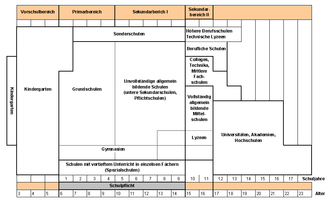
The education system in Russia
.jpg)
Seminar room of the Law Faculty of St. Petersburg State University
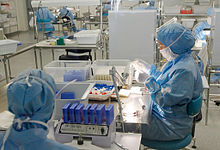
Production of membrane filters for blood plasma with new nanotechnology in Dubna Special Technological Economic Zone
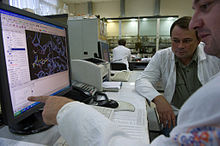
Laboratory technician performing experiments in the laboratory of the ChemRar High-Tech Center, Moscow Oblast.
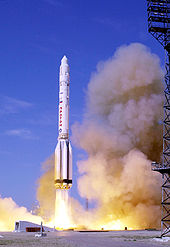
Launch of a Proton-K launch vehicle

Physics Research Seminar at the United Institute of Nuclear Research in Dubna
Questions and Answers
Q: What is the official name of Russia?
A: The official name of Russia is the Russian Federation.
Q: How many people live in Russia?
A: Approximately 146.7 million people live in Russia.
Q: What language is spoken in Russia?
A: The official language of Russia is Russian, which is also the most widely spoken Slavic language in Europe.
Q: What are the four largest countries in the world?
A: The four largest countries in the world are Russia, Canada, United States and China.
Q: How many land borders does Russia have?
A: Russia has 16 land borders with other countries located both in Europe and Asia.
Q: What religion do most Russians practice?
A: Most Russians practice Eastern Orthodox Christianity.
Q:What type of government does Russia have today?
A:Russia currently has a federal semi-presidential republic government with elements of democracy.
Search within the encyclopedia
